
- Start here!
- Travel Resources
- Blogging Resources
- Pre-Travel Checklist
- Books I’m Reading
- Start Your Own Blog
- What’s In My Backpack?

The Best Travel Cards And Bank Accounts For Kiwi Travellers
published by Bren
Last updated: May 23, 2023
QUICK SUMMARY
The best travel card for Kiwis right now is the Wise debit card.
To be frank, it's in a league of its own right now and there is nothing close to it.
It allows you to load NZD and exchange it to all other major currencies at a fair rate (better than any NZ bank rate).
It also allows you to get bank account numbers (!) in other currencies, so you can receive payments in those currencies.
Finally, it's all manageable within a very modern and easy-to-use app.
If you do not wish to sign up for a Wise card and want to just use your NZ bank, the best option right now is ASB.
Their fees for ATM withdrawals are the lowest, so you can get yourself cash in practically any country in the world without losing too much in fees.
This article is a part of my travel tips series for New Zealand travellers. If you're not from NZ, this post won't apply to you. You can see the rest of the Kiwi traveller guides by clicking here .
As a New Zealander, trying to find the best travel cards and banking options has been a frustrating affair. Why? There's just not that much to choose from.
Banks in larger countries are faced with higher competition and are forced to give their customers bundles of perks, while in NZ the banks enjoy a nice oligopoly which leaves us at the mercy of a few big players.
What that means is we never enjoy double and triple frequent flyer point deals, large signup bonuses, zero foreign transaction fees and ATM fee refunds. We don't have great travel credit cards or reward schemes. Very unlikely that you'll be getting free lounge passes or New Year bonus points.
However, there are still a few good options for us Kiwi travellers. And of course, it's still important that you don't lose money. With the wrong setup, you can end up paying hundreds in fees for currency conversions, overseas ATMs, interest, monthly and annual fees and more.
That's what I'm gonna help you with today.
In this post I'll break down the best travel cards, bank accounts, and some other lesser known options, and show you how over ten years of full time travel, I've managed to keep my bank fees down, gain several free flights on Airpoints, all while enjoying affordable and easy access to all my money, in various currencies, anywhere in the world.
Note: This is a long post with a lot of numbers. If you don't care for the analysis and just want to know what cards/accounts to get, you can skip straight to the bottom.
Part 1: Getting rid of ATM fees
The main way I access money while travelling is via ATM.
Not everyone knows this, but you can use ATM's overseas exactly the same way you use them in New Zealand. You get cash in the local currency, usually get a very good rate, and it comes straight out of your normal NZ bank account. It's very safe and easy.
In many countries, I never use a credit card or travel card at all. I just visit the ATM once or twice during my trip, and use cash for everything.
However! If you don't set up your bank accounts right, this can end up costing you a lot in fees.
Here's an example of when it doesn't work out so well for you:

I wanted to withdraw 10,000 Philippine pesos, which is around $265 NZD. At the time of this withdrawal, the interbank exchange rate (the 'real' rate that banks use) was around 38, and I was given 38.34.
So instead of paying $265, I paid $266.04.
That's a pretty good rate. At one of those currency exchanger booths, you'd lose 2-3% off that at least.
However, let's look at the fees here:
Offshore service margins: This is a fee they charge for withdrawing foreign currency, and will usually be between 1-2%. In my case, the fee is 1.1%, or $2.93 (that's actually low for a NZ bank).
Overseas ATM Fee: This is a fee charged for using an ATM outside your banking network. It usually ranges between $5-$10. In this case it's $7.50 (quite high).
Local ATM Fee: This is a fee the local bank will charge for using their ATM (everyone takes a cut!) As you can see, I wanted 10,000 pesos, but got charged 10,200. That extra 200 is the usage fee (around $5.50).
So for one $265 withdrawal I've been charged $3 in service margins, $7.50 by my NZ bank and $5.50 by the local bank whose ATM I'm using.
That's a total of $16 for one withdrawal. If I do that once a week it's going to add up to around $700 a year - not cool.
So, how do we avoid this?
Choose a bank with no foreign ATM fees
When I first wrote this article a few years ago, the only bank that offered free foreign ATM withdrawals was Westpac, through their membership with the Global ATM Alliance .
Things have changed since then.
In early 2018, ANZ announced they were waiving ATM fees both in NZ and overseas, and ASB followed suit later in the year and BNZ not long after that. Meaning most banks in New Zealand now waive all foreign ATM withdrawal fees.
However, if you really want to see who gives the best deal, we need to add up all the fees involved:
Overseas ATM fee summary (updated May 2020)
As you can see, ASB is easily the front runner here. But what we really care about are actual dollar amounts.
Here's what your fees will look like when making the following withdrawals at an overseas ATM:
This picture was a lot more complicated just one or two years ago, but now there's no contest when it comes to the best bank for NZ travellers: ASB .
The bank account I use is their Streamline account , which is managed entirely online, has a free EFTPOS card, and no fees.
How do you use a NZ EFTPOS card at an ATM overseas?
To use your NZ EFTPOS card at overseas ATMs, it works exactly the same as it does back home.
As long as your Eftpos card has a PLUS, Cirrus or Maestro symbol on the back, you can use it at almost any ATM in the world.
Check the back of your card and you should see one of those symbols, most NZ cards are either PLUS or Cirrus.
For example, here's the back of my ASB card with the PLUS symbol:
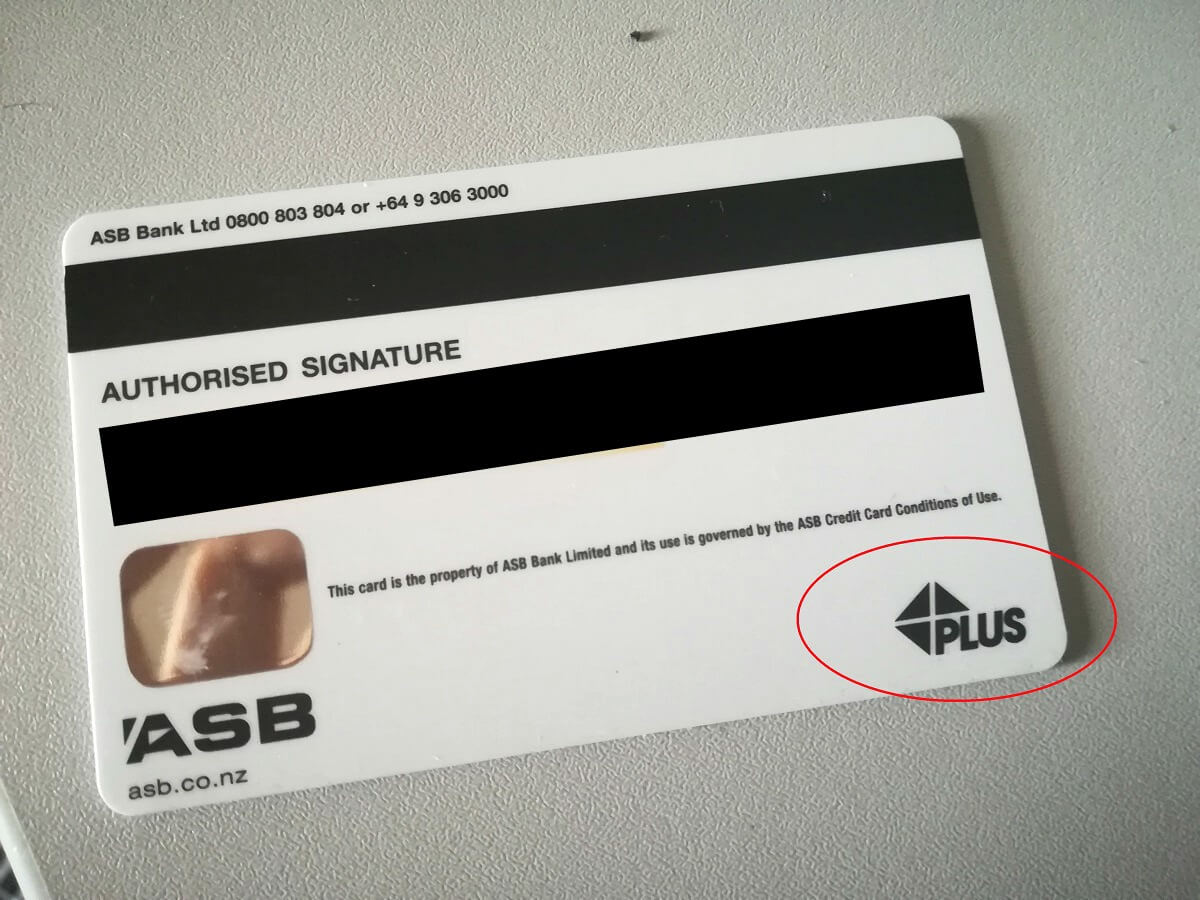
Then when you visit an ATM, you'll see a sticker that shows what cards they accept, it will look like this:

Since those symbols are displayed there, it means your EFTPOS card will work just fine.
Just put it in, enter your PIN and away you go.
It's also really important to remember not to choose "credit" when you make your withdrawal. Choose check or savings or whichever your bank account is connected to.
If you choose credit, it will not be an EFTPOS withdrawal but a cash advance on your credit card. That incurs interest, a worse fx rate and maybe some other fees as well.
Part 2: Prepaid debit cards/travel cards
These types of cards the best travel cards available today when it comes to fees/usability.
They allow you to pre load different currencies (around 9 different ones) onto a prepaid Visa or Mastercard, meaning you can make purchases/ATM withdrawals in those currencies without paying the foreign exchange fees.
Some also offer free ATM withdrawals.
The 3 main ones available to New Zealanders are the Air NZ Onesmart, The Travelex Cash Passport, The Wise Debit Card and the Loaded for Travel card.
First off, Loaded For Travel has been phased out. You might still see people using them, but they're no longer being issued as of 2020. So that one is out.
Let's compare the other three. We'll look at the foreign exchange rate, the fees, and the overall ease of use for each card.
As a benchmark, right now the NZD/USD rate is 0.6185, so we'll base our analysis below on this:
The Air NZ Onesmart card is a Mastercard debit card by Air New Zealand. It is managed via your Airpoints account and is pretty easy to use.
When looking at the rate, here's what you'll get when loading $1,000 NZD into USD.

$1,000 NZD gives us $595 USD.
That's not very good.
With an interbank rate of 0.6185, that means they're taking a cut of 3.7% (that's a lot).
There is also a load fee of 1.5%, a currency conversion fee when you use the card of 2.5%, and a $1 monthly fee.
However the Onesmart does give you other perks, such as earning Air NZ Airpoints on your purchases and 3 free ATM withdrawals a month.
Getting the card is free.
Travelex Cash Passport
The Cash Passport is a travel debit card available from Travelex. You may have seen their currency exchange booths and ATMs in the airports.
Here's their current rate when loading $1,000 NZD to USD:

$1,000 NZD gives us $605 USD.
That's better than the Onesmart (which gave us $595).
The rate is 0.6055, compared to the interbank rate of 0.6185, so they're taking a cut of 2.1%. Not extravagant, but not great either.
Travelex also has a bunch of other fees:
- $10 initial load fee
- 1% subsequent load fee
- $4 monthly inactivity fee
- $10 closure fee).
Looking at that you're already guaranteed $20 in fees to simply open and close an account. ATM withdrawals are free.
Could still be better than a Onesmart, depending how often you plan on using it.
Wise Debit Card

Wise is a European money transfer service, but started offering debit cards and "borderless" bank accounts a few years later.
Their debit card came out around 2018 for Kiwis.
I've been using it and it's been pretty great.
Here's what rate you get for loading $1,000 NZD to USD.

At a rate of 0.6186, that almost exactly matches the interbank rate to four decimal places (actually slightly better).
So the currency exchange fee they are taking is zero. That's amazing.
Of course they also have a fee like the previous cards, which here works out to $7.83, or 0.7%. That's really low!
Ordering a card is not free; it costs $14 NZD.
After that there are no monthly fees, and you get free ATM withdrawals of $350 per month (2% thereafter).
There are also many other perks to owning a Wise card - you can open bank accounts in various currencies, get an IBAN number, and receive money in foreign currencies too.
So which prepaid travel card is the best?
Let's put all that info together and see if we can get a winner:
First, the Onesmart exchange rate is so crap that I would disregard it altogether - there is no way you would save money with it when you're losing 3.7% every time you load money.
That leaves Travelex and Wise.
Because the exchange rate is also rather terrible for Travelex (and literally perfect for Wise), that would be enough for me to recommend Wise outright.
Add in the fact that Wise has no closure fee, no inactivity fee, no monthly fee, and the cheapest load fee by far, and it's a no brainer.
The $14 set up fee is the one downside, but it is a one-off, and over the long run is easily worth it. In fact, you will make that back in savings the first time you load money.
Travelex also ran into financial problems in early 2020 , and it seems risky to have money stored on one of their travel cards right now. Them disappearing is not impossible.
So easy decision here: Best prepaid travel card for Kiwis is the Wise Debit Card.
You can sign up for yours here .
Part 3: The best travel credit card for Kiwis
Let's move onto travel credit cards.
The trick with credit cards is to minimise your fees, never pay interest, and try and earn some reward points along the way.
We'll start with fees. What are some of the fees you typically pay with credit cards?
Here's an example:

For this particular transaction, I purchased a $111 USD air ticket on Cambodia Angkor Air.
On that date the interbank rate was 0.875, and they gave me 0.873. That's good.
But you'll also see I got charged fees of $3.18; around 2.5%.
I personally do not want to add 2.5% to everything I buy, just because I'm using plastic.
Unfortunately there is currently no bank in New Zealand that offers a credit card without foreign transaction fees , so this is unavoidable.
However, having a credit card is very handy during your travels, so I think it's a good idea to always have one on you, even if our options aren't great in NZ.
Since there are literally hundreds of different cards available in New Zealand, I'm not going to compare them all. What I will do is compare a few "free" credit cards to see which gives us the best deal.
The following credits cards all have no annual fee and are reasonably easy to get approved for:
All are pretty similar across the board.
The main differentiator is the ASB Visa Light has no cash advance fee, meaning any ATM withdrawals are free. They should be free anyway on your EFTPOS account, but have this as a safety net is great as well.
The other thing is the AMEX Airpoints card is free and gives you a chance to earn Airpoints, plus you get a $50 signup bonus - that's also important and I'll address that more later.
Let's take a look out how these fees actually translate into numbers. These are the fees you would pay if you made the corresponding purchases or ATM withdrawals:
The ASB credit card is best if you'll need to make ATM withdrawals.
The Kiwibank card is best if you'll want to make actual purchases.
This is under the assumption you pay the bill on time and don't incur any interest.
Either way, credit cards should be a backup only , and you should use your ASB EFTPOS for ATM withdrawals and Wise debit card for purchases on the road wherever possible.
Don't forget about Airpoints!
This is more a tip for while you're in New Zealand, but make sure you're taking advantage of Airpoints!!
If the average New Zealander uses an Airpoints credit card in their day-to-day life, they should easily get a free air ticket to Aussie or Bali each year.
If you're after a good, cheap, fast-earning Airpoints card to use, the American Express Airpoints card is the easy winner.
It's the only zero-fee Airpoints card there is , plus the Airpoints earn rate is even better than some of the more expensive cards from the NZ banks. I'd highly, highly recommend applying for it today while it's around. Often they also have a $50 signup bonus, which makes it an absolute no brainer. Check here if the bonus is on offer and to get your free card .
For a more thorough breakdown of Airpoints cards in New Zealand - I've got an entire guide which analyses every single Airpoints card available in New Zealand. You can check it out here.
Another credit card tip: Paying in NZD (if it's a good deal!)
Sometimes shops and websites will ask if you want to pay in NZD instead of local currency.
This can be a good idea sometimes.
Whenever the shopkeeper asks if you'd like to pay in NZD, always ask what the amount will be. Then pull out your phone and do a quick conversion (I use the Oanda app) and check if it's a fair amount.
Nine times out of ten they will be taking a big commission on the exchange rate. That means even though you'll avoid FX fees on your credit card, you'll end up paying more to the shop and it will probably end up costing you more overall.
There are good opportunities to do this though. Take a look at this example.
This is a hotel booking form from one of my favourite booking sites, Agoda . It's for a hotel in Bangkok:

Their prices are USD listed ($88.55), however they also give me the option to pay in NZD ($102.25).
If I choose to pay in NZD, I'll be getting a conversion rate of 0.866, compared to the current interbank rate of 0.867.
That's very good, and much better than what AMEX will give me if I pay in USD and let them convert it (it was around 2.5%, remember?)
Therefore I often make online bookings in NZD (assuming the rate is good), which eliminates foreign transaction fees, and also lets me earn some Airpoints along the way.
In the case that it's better to pay with USD, just use your Wise debit card.
Summary for the best travel credit card:
There is no 'good' travel credit card in NZ (that I know of).
However, it's always good to have one anyway. My recommendations are:
- An ASB VISA Light as a backup.
- An AMEX Airpoints card to earn the $50 signup bonus, and earn Airpoints on all NZD purchases.
- For everything else, use the Wise Debit Card .
So which travel cards/bank accounts do I use?
Here's the summary of what I use currently to keep my fees as low as possible and money as easily accessible on the road.
The main card I use while travelling is my Wise Card . Nothing else is anywhere near as good.
However, as backups:
- I have an ASB Streamline Account (no fees), which I use to withdraw larger amounts of money from ATMs. I have never visited a country where I could not do this.
- I have an Airpoints American Express (no annual fee), which also has no fees and earns me Airpoints. I barely use this while travelling, but I use it for pretty much everything I buy while in New Zealand . If you're not already, I'd highly recommend signing up for one today and start stacking Airpoints! I also recommend you read my guide on travel hacking for Kiwis .
- Lastly, I carry a small amount of USD in cash for emergencies.
Between these options I manage to keep my bank fees almost non existent - in fact you might have noticed every single card has no annual fee.
I also get to earn a few frequent flyer points along the way. Pretty good, no?
What should you use?
If you're on a shorter trip (say 2 weeks - 1 month), it becomes much less important what card you will use.
If you're just going to Australia, you can simply use your NZ Eftpos card to get money from ATMs. You can even use your ANZ and Westpac cards and their equivalent ATM in Australia.
If you're going on a longer trip, or travelling around the world, you absolutely need a Wise card . That option can hold you down in almost every country. Keep an ASB Eftpos card handy, and possibly one other bank account too as a backup.
Best of luck in your travels and as always, if you have any questions, drop them in the comments below.
Loved this? Spread the word
You might also like:
How i spent two weeks in mauritius, training at smash travel in bali – a review, where to stay in bali the ultimate guide, running port vila: ten days in vanuatu’s capital, share your thoughts.
Your email address will not be published.
Another great usuful post Bren! I have done some researched on it myself and thought that the best option for me is ANZ (i have been a custumer for a long time anyway) and a Loaded for travel, which I manage to use a lot as an EFTPOS card to avoid withdrawn fees, also the exchange rate was much better than cash passaport everytime time I looked and I really like the fact that the maximum load fee is NZ$ 10, depending on how much you want to load that can really make a difference. I avoid inactitve fees using my card now and then in NZ and plan on using it for the 2 years the card is valid for so wont pay to cancel it. I heard, but have not verified, that if you put money into your normal credit card, as in paying it more that you owe, you dont pay international transaction fees, It would be pretty good if it is true but I am still very jealous of canadians and americans with their awsome deals and rewards!!!
I also heard that you don’t pay fees if you credit card is loaded with cash, but I double checked this with ASB and they said it doesn’t work like that. Otherwise I would definitely be doing that. I haven’t checked with the other banks though. Doesn’t Loaded for Travel cost $6 per ATM withdrawal? At least that’s what their website says.
I feel like I remember reading in your elance post that you worked in finance or something before.. not surprising looking at all these graphs and charts lol!
Yes, I can obsess about dollars and cents sometimes… 🙂
Great post – thanks for doing all that research and sharing it with everyone. I’m on ASB and whenever I travelled I would just withdraw and didn’t give those fees much thought but next time I travel I’ll think about getting a Westpac card. Although bank fees are a pain – a better way to think of it is at least we have banks and don’t have to carry suitcases of cash everywhere we go! So you can look at those fees as payment for their services such as keeping our money safe 🙂
That’ true, and I don’t mind paying bank fees at all, however, $13 just to get my own money out of an ATM – that’s a bit much for me. I know it doesn’t cost the bank that much, because if ANZ and Westpac can let you do it for free and still stay in business, I’m sure the other banks too 🙂 I’m also with ASB, however I’ll be winding down my accounts with them soon and shifting to ANZ (and I’m already with Westpac). Glad you found this helpful, and happy travels 🙂
Yes, they do charge $6, I didn’t express myself very well. What I meant is that I tried to pay with my card as much as I can instead of getting cash from an ATM. For the amount of money I loaded for my Italy trip I would have to withdraw cash many times for Loaded for travel to be more expensive than Cash passport because of the loading fee and exchange rate difference. So I guess it depends on the trip, I had a spreadsheet with all the fess and some scenario testing to help me chose 🙂
Ahh I get you, yes the exchange was quite a bit better on the LFT card. All depends on how you plan on using it I guess.
Thanks for that info Bren. I emailed you through a question in regards to the money situation about a month ago and wanted to thank you for your reply. My partner and I decided to go with the westpac credit card and the Air NZ Onesmart card as we already had both of these. Thanks for all the other informative blogs. Off to Indonesia next week to start our backpacking adventure around asia!
Hi Alan, you’re welcome, enjoy Indonesia and all the rest Asia has to offer!
Hey Bren – this post couldn’t have come at a better time for me, so thank you! I’m an ANZ customer and will be travelling through Asia. I was going to go with a Loaded for Travel card (so at least I could have baht for Thailand and USD for Cambodia) but the $6 ATM withdrawal fee is ludicrous! I’m looking into just taking my debit card and sticking to ANZ ATMs, as per your suggestion – do you know if they still charge the currency conversion fees?
Yes I believe they do, I know Westpac does anyway. I don’t think any bank in NZ lets you off those, but the rate can differ (ASB is only 1.1%, compared to Westpac’s 2.5%
Hey, thanks so much for this post! With the Global Alliance/Westpac account – do you know if there are fees if you use the eftpos card like an eftpos card overseas, or would it just be the offshore service margin charged? And the same question in regards to the prepaid credit cards – if you used them like an eftpos/credit card, are there any fees? I presume there is not offshore service charge because the money has already been changed to the local currency…
As far as I know the Westpac card can only be used for ATM withdrawals. As for the prepaid cards, there will be no fees if you have money loaded in the correct currency. Hope that helps!
Hi Bren – I’m off to the States for a month and was planning on using my Westpac eftpos card at bank of America ATMs (global alliance bank) to withdraw cash, and then was tossing up between using my Westpac debit plus card or a Onesmart card for any credit card transactions. What would you recommend? Would hotels, car rentals etc accept the Onesmart card? Also, do you know (from your experience) whether the States is a cash friendly place to visit or do merchants prefer credit cards? Thanks!
Yes I was also using my Westpac card in the States, there are no ATM withdrawal fees but they do charge a currency conversion fee when you make a withdrawal which was quite hefty at 2.5%. Sometimes it was cheaper to use my ASB card if withdrawing a large amount, which charges $7.50 + 1.1%.
If you’re only going for a month it will probably be cheaper to use your debit plus instead of activating a Onesmart. The Onesmart doesn’t give as good exchange rates, and plus, it’s biggest advantages are the free ATM withdrawals which you can get on your Westpac anyway.
To answer your other questions, the Onesmart should be accepted anywhere that accepts Mastercard. Most of the states should be card friendly – depends on the city I guess. It’s a big place!
Hope that helps, Bren
Have you done any research on opening up accounts with international banks? I know a lot of my American friends use Charles Schwab. They offer great interest rates and no fees for overseas ATM withdrawals.
I’ve been meaning to check into it for some time now but haven’t gotten around to it.
I haven’t looked into it but I think you need a US residency to open a Charles Schwab. Most American travellers I know use them also, they’re very good.
Hey Bren! Thanks for sharing this 🙂 We are also from NZ and last years atm fees in Vietnam were such a bum for 5 months! so now were more prepared 🙂 keep sharing, good stuff!
Hey Kate, no worries! I think there’s an ANZ in Vietnam if you’re heading back. As a side note I’m moving to Cash Passport over Onesmart because the exchange rate is better, in case you’re going that route.
This post was exactly what I have been looking for. Joining ANZ however does not seem very helpful as to get to the ATM locations would cost me more than the fees required normally, the ATMS are too far and few. Thanks for this post however very helpful and informative.
I am planning on using the westpac card in most of my journey through Europe and USA but I will be doing a bit of travel in Asia first so I have just done a bit of research, and looking at Westpac, BNZ, ANZ and Kiwibank they all charge 2.5% plus the ATM withdrawal fee Which varies from $5.00 to $7.50. In this case would the AirNZ onesmart card not be the best option as they charge minimal fees and includes 3 free withdrawals per month potentially saving you $22.50 a month. As stated above I would not really be willing to go with the ANZ card as it seems to be a bit awkward to get to the ATM locations.
Are there other hidden transaction costs that I am not seeing here with the onesmart card? Would like to know your thought.
Regards, Stevo
Gday Stevo, the thing with the Onesmart is it doesn’t give a very good exchange rate, so this adds up over time. On a big withdrawal the difference can be up to $20 or $30. Last I checked ASB only charges 1.1% plus $7.50 – in USA and Europe, where you can make quite big withdrawals, this can work out better than Westpac’s 2.5% even after the $8 fee is waived for alliance ATM’s. I have an ASB, a Westpac and a Onesmart and I cycle them, depending on the situation. Annoying, I know.
Hi Bren, thanks for your post!! I’ve been searching online for days trying to find info about NZ travel/credit cards. My eyes hurt. Real bad! My problem is that I’m travelling to South America, where the currencies aren’t an option on any of the travel cards … and if I had NZD on the Travel Cards, the huge 5.75% conversion will likely wipe out any benefit of no ATM fees in the long run.
After my own research comparing foreign curency conversion rates, atm withdrawl fees and card fees, I’m leaning towards opening a westpac debit account, simply to avoid the ATM fees. My question to you, is whether you have travelled SA and whether you had any trouble finding the global banks aligned with Westpac to avoid fees???
I will also keep my ASB cards as the give a marginally better conversation rate than westpac. (2.1% so I’m interested how you get 1.1%!!)
Thanks in advance. Megan 🙂
I’ve been to SA a few times but the global alliance doesn’t have great reach throughout the continent. I’d say it’s best to use a cash passport or an ASB. As for the service margin – this is from ASB Fastnet – ** The Offshore Service Margin is 1.10% for a FastCash overseas withdrawal and 2.10% for a Visa Debit overseas transaction.
In other words, withdraw from your ASB checking account rather than your credit account.
Hi Bren, heres a scenario… i am in Spain and log onto Google NZ and book accommodation with my NZ credit/or debit card buying in NZD (obviously) and paying no foriegn currency changes. (Because the bank see’s a NZ transaction being processed in NZ even though i am in Spain)…. hows that sound? And is it possible?
Cheers Graham
Hi Graham. Usually the website is very clear on which currency you’re being charged in. It’s possible to book accommodation in NZD on international sites and I do it often (e.g. hotels.com, agoda). And yes, that will avoid the foreign currency rates. The only thing to look out for is to make sure you’re getting a fair exchange rate. Cross check the price you’re given with current rates and see if it’s a reasonable conversion.
Hi Bren, Just been reading your useful article. Regarding credit cards. I have a Warehouse Credit card and overseas transaction fees are only 1% ! This is easily the cheapest. Check it out! Cheers Paul
PS I am in the process of contacting Charles Swarb bank USA re opening a no fees chequeing ac in USA for a Kiwi resident. I will post on their reply.
Hi Paul. Nice find. I probably won’t be using my credit card too much overseas until they bring one out with 0% foreign transaction fees + Airpoints. Until then I pay with most things in cash. Do let me know what Charles Schwab say!
Hi Bren, Just had an online chat session with Charles Schwab. It is possible to open an account with them for free chequeing and them also providing a Visa card ! (don’t know limit though) BUT the catch is to open an International account the minimum deposit is US$10000!
Hey I’ve been booking in NZ dollars on the accommodation sites and I still get charged the 2.5%(WPac) charge every time. It has after all been converted from a currency that is not mine at some stage!! Westpac credit cards WERE free if your card was in credit but they axed that about 6-7 years ago!!
If the site charges you in NZD it shouldn’t incur a charge. I don’t have a Wpac credit card so can’t say if what is happening to you is normal, but on my Kiwibank and ASB I’m getting charged in NZD with no currency conversion.
Hi and thank you! I am going to Cambodia and so got myself a ANZ account for free ATM cash withdrawals but will have to pay 2.5% conversion. My Kiwibank Air NZ mastercard only charges 1.85% conversion but $6 for ATM use abroad PLUS it says possible extra charge from the overseas bank you withdraw from. Any experience of this double ATM charge in Cambodia please? Difficult to work out which option will cost less.
I’ve been using my Kiwibank Mastercard more and more just because the fee is relatively low and it’s convenient. I don’t remember if the local ATM charged fees in Cambodia. ANZ banks are there but I only saw one or two. They use USD there too. If you’re only there a short time take some USD and you may only need to make one withdrawal, so the cost should be negligible.
Awesome article. I didn’t know about the Westpac online account – this is really helpful, thank you!
Great article. We are getting slammed in Central and South America using our ANZ australia account, so have switched back to kiwibank (unfortunately not much cash on that side of the ditch). ANZ Australia and Westpac Australia both charge a 3% (!!!) foreign currency conversion fee for ATM withdrawals and CC purchases, plus the spread on the conversion (usually quite low) plus the ATM fees (not for CC obviously).
Kiwibank charges 1.7% which is pretty decent. I have an ASB account but left the card at home unfortunately, didn’t realise their rate was 1.1%.
To answer the global alliance questions, the only countries in Central and South America that are included are Mexico (apparently difficult to find but I never tried), Peru and Chile. We are only in Ecuador so can’t comment on the latter two but will hopefully chase them down when we are there.
We’ve found the best way to avoid getting screwed over was actually the cash we withdrew (AUD) and got changed to USD before leaving NZ at a little Chinese currency conversion place in Newmarket (spread was about 1.5% I think). Many places accept USD here and if you look, you can find good conversion rates in some countries and at most borders (be careful, a tired me got done at the Colombia/Ecuador border because I wasn’t paying attention, but the rate WOULD have been good!). Nicaragua for example was the best, they basically converted at the mid-market rate everywhere.
Also, had a look at the Charles Schwab thing. You can sign up as a non-US resident, but I believe you need a minimum $25k USD and also looks like there’s a tonne of paperwork, so not for us at current, but maybe kiwis planning on travelling can look into this if they have time. Our US friends are always rubbing it in our faces…
Thanks again JC
Yes, Ecuador is great because they use the USD. Westpac is only okay because you don’t get charged the $8 ATM fee, but they still charge currency conversion at 2.5%. ASB is still the best I know of for that region. Just try and take your money out in big chunks to keep the number of withdrawals as low as possible.
Hi Bren I live in the USA and I have a ASB card that I use! What is the best option for me to cut down on offshore fees?
If you live there you should open a US bank account!! They are far superior to anything we have.
Hi Bren, thank you for the article. Appreciate the work you have put in explaining these financial issues to a lay person like me. Can I ask if you know of the best travel card for Thai Baht? I will be heading to Thailand, Cambodia, Vietnam and Laos but most of my time will be in Thailand. I bank with ASB and have a Visa Debit Card. Thanks,
Hi Colm, Thailand is not great for Kiwis when it comes to currency. I would suggest just taking one big lump sum out on your ASB cheque account, it will cost you $7.50 + 1.1%. Alternatively you could do it in Cambodia, because the ATMs there give USD, then you can change that to local currency in the other countries.
Hi Bren, Great information here about the charges on the cards and the best ones to use overseas, but the other side to this is the customer service backup when things go wrong. I am currently in Spain and have a Loadedfortravel card (for the second year running) and it’s has been great and cheap however it has been skimmed and all money gone. I have contacted Kiwibank many times over the last 10 days and they have been so unresponsive and I cannot believe the lack of response to this serious situation. There systems and customer support are obviously not sophisticated enough to deal with problems when things go wrong. People really need to check the support they will get before deciding on which card to use. They should definitely use one of the bigger banks and not Kiwibank and Loadedfortravel.
Hi Louise, thanks for the tip. I’ve never used that card so I’m not sure what your recourse could be. However, if you don’t have any luck with Kiwibank maybe your travel insurance will help you out.
Really good information thanks! Just wanted to let people know if they travel to Singapore and Malaysia, moneychangers are very heavily regulated by the respective governments. Rates only vary by a small amount OUTSIDE THE AIRPORT and are much better than anything you’ll get with a credit card, there are also no fees. But NEVER ever change your cash at the airport, the rates are terrible and nobody local would ever do that! There are moneychangers in most medium to large shopping centres/malls. In Singapore for example, just take the MRT train 10 minutes (at a cost of no more than $1.60) to Expo Station and use the moneychanger in the shopping centre next to the station entrance… You could also pick up some inexpensive but great local food in the food court at the same time!
This is so helpful, thank you so much! Unfortunately, I’m living long term in Indonesia but unable to open a local bank account. THere’s no option for any pre-loaded travel cards in Indonesian rupiah. I get charged about a total of $10NZD for every withdrawal (which I try and minimise but it is difficult). I don’t suppose you have come across any extra information about money saving tips for this region? I’m with ASB and generally use my ASB visa for all withdrawals etc. Love this blog post!
Try open an ANZ account. I believe they have branches in Indonesia.
Hi guys, I leave for Singapore coming Saturday and then 12 hours later leave for South Africa, Just wanted to know with about $3500 spending money, should I exchange some cash here in New Zealand and load some on a card? Which is best please? I would also lie to know whether I should just use a card in Singapore since I don’t plan to spend much there?
If it were me, I would just withdraw everything from ATMs in South Africa. You can either just use your eftpos card or if you prefer you can get a travel card. However, if you’re planning on spending all that money in SA and you prefer to use plastic, then you could get a travel card and load it all as South African Rand. Loaded for Travel is probably the best card for that amount of money as there is no load fee. If you’re only in Singapore for 12 hours you probably won’t even leave the airport, and you can use any major currency in the airport. If you do leave you could just change a little currency in the city, won’t be a big deal if it’s just a small amount. Have fun!
Hi Bren Wow what a lot of info, it’s all very overwhelming, but like you, I hate banks getting anymore money than necessary. We are off to the UK, Europe and Dubai and am just debating how much cash to carry vs loading my Onesmart. We can get an exemption of fees at the airport for buying currency but are the exchange rates worse than at the local branches, wondering if it’s worth our while? We also bank with ASB and hadn’t even considered just using an ATM card. Decisions decisions, any hot tips for Europe would be much appreciated. Regards
It really depends on so many things – Euro UK and Dubai probably means you can use plastic a lot and if you’re planning on loading a lot of money the Loaded For Travel card can work well because there is no load fee. There are Global Alliance ATMs in UK and Europe so you can use Westpac for free ATM withdrawals but they charge 2% conversion fee anyway which can add up to quite a lot. But try and figure out which one will work best based on your budget. ASB is fine too – they charge 1.1% but charge a flat $7.50 per withdrawal, so it can still work out cheaper than Westpac depending on how big your withdrawals are. Onesmart is probably not a good idea as the rates are usually really bad on that.
Great tips Bren My ASB Visa Platinum reward card has a 2.1% foreign currency fee but then that is offset by the accumulation of 1% true reward benefit so I’m thinking that using that card extensively where ever it is accepted is a better option at 1.1% net, than paying cash by using a Westpac Card at Alliance ATMs which has a 2.5% foreign currency fee. This assumes that the retailer/supplier has not applied an additional local credit card fee in the credit card transaction. What am I missing?
This is true as long as you account for your True Reward Fee and your Platinum card account fee and if the country you’re visiting accepts cards everywhere. The reason I like using cash is because a lot of the places I go to are cash only (markets, street food, cabs etc) and I don’t need to carry my card everywhere. Plus I often use my ASB cash card over my Westpac at ATMs these days, as the fee usually works out lower. Crunch some numbers and if it works out cheaper for you to go Visa then go for it!
The Gem onecard Visa now has a currency conversion fee of 1.9% and foreign ATM and cash advance fee of only $1.50! This means you have to get over $750NZD from an ATM before the ASB EFTPOS card wins. By simply prepaying your credit card you avoid the interest on the cash advance. It costs $65/yr but free for the first 12 months. I’m planning on travelling to Nepal with this card and then cancel it at a later date in preference to using my Air New Zealand American Express Card for Airpoints 🙂 What are your thoughts on that plan?
Sounds good! Also if you don’t mind micro-managing your cards (opening and cancelling constantly) you could keep this up for quite a while, as most credit cards in NZ have “special” signups where they’ll waive the annual fee for a year and give you all sorts of other bonuses (Airpoints etc). Just gotta keep an eye out!
Also the Warehouse Purple Card has similar rates but has no annual fee – check that one out too 😉
Slightly different thread but the lounge benefits of the Amex card rocks! Recently had a 7 hour stop in Sydney and the lounge pass was worth it’s weight in gold. The free food and grog was spectacular,we were like kids in a candy store. Nearly worth flying to Sydney for lunch!
Which Amex card have you got?
Thanks for great info Bren. Used Westpac alliance to withdraw cash on last trip mainly in France and Italy. This time it is Croatia and Greece – seems no global alliance ATM options there and no ANZ branches. Any tips?
I usually just use an ASB eftpos card and will take the max withdrawal out of the ATM. Because Greece uses the euro it’s not a big deal if you have some leftover – you can just keep it for another trip or it’s easy enough to change back if you need to. Croatia uses the kuna so a little more tricky – depends on how long you’re staying there. If it’s just a few days, exchange a little euro at a currency exchange with a decent rate. Not perfect but will get the job done.
Hi Bren. What a can of worms this is. You’ve done a great job here of letting people communicate ideas and ask questions. I’m heading away shortly to Britain, Europe and the States for a total of 4 months. Fortunate to have a son in England who will get me Euros and Pounds, which has the disadvantage of carrying a lot of cash, but which avoids a lot of fees. I can load up my ASB Visa so that it is in credit and any overseas ATM withdrawals come out at Fastcash rates of 1.1% which is comparatively pretty good I think. I’m still trying to work out if ASB is the best option as credit card. Because we’re away for such a long time I’ll still be making a lot of CC purchases. I’ll get True Rewards points but I’d love to pick your brains to find out if you’re aware of a better solution. Thanks heaps
I had a friend who used the Loaded for Travel debit card. Because she was buying everything with plastic it worked out best for her – it has a low loading fee and she never did ATM withdrawals. Also look into the Warehouse purple cards – they’re pretty good!
Thanks so much for all your advice Bren on this site, it has really helped me a lot on my travels. Can I ask for your thoughts here…im going to North Cyprus for 8-10weeks. They use Turkish lira, but also evidently Euro and English Pounds are accepted. I have an ANZ debit card and a Onesmsrt Card. I’m in Finland at the moment. What should I do money wise.. I leave next week. I am not making money so am always using NZ dollars as my main source.
For that period of time I would probably avoid using your Onesmart. The exchange rate will catch up with you a lot. I you’re comfortable carrying around a large amount of cash, I would just take a big withdrawal in Finland and try and use cash. Although in Cyprus you could probably just use your card to pay for most things – I’m not sure though as I’ve never been there.
Thanks for the reply. Wish I had known about your site sooner! I am planning to try and be away for at least 12 months. Unfortunately I didn’t realize Onesmart had such high fees. Sorry to ask another two questions…so am I actually better off using my ANZ eftpos visa debit card in atm machines rather than converting NZ dollars to euros on my Onesmart card and then using that to withdraw money. Also is it worth it now or is it even possible to change to another travel wallet now or perhaps i shouldn’t bother. Thanks Been in advance for your suggestions..working out the money side of things when travelling is not my strong point! I’m hoping to do volunteer work through work away to keep me going
I actually haven’t checked the Onesmart exchange rate since a few years back so it might have improved. Maybe you can go and compare the rate you’re getting from Onesmart with the rate ANZ gives you. But with the data I have it looks like your ANZ card would be better for actually paying for things with your card. If you’re doing ATM withdrawals, you could probably use either card without much difference. ANZ would give you a better rate but Onesmart ATM withdrawals are free, so it will probably even out. Again it really depends on how much you withdraw and how often.
Thanks heaps for your article. I am travelling to Switzerland for 6 weeks shortly and I am wanting to know the best way to get money and pay for things while over there. Since swiss francs isn’t a currency used on travel cards, is it best just to use an eftpos card? I am wondering if it is better just to use my Westpac eftpos card at shops since doing this or using an ATM will have the 2.5% fee but if i use an ATM I will get charged an additional $3 per transaction?
Thanks for your help. Ben
You can’t use an EFTPOS card to buy things there, only to withdraw from an ATM. The best card to use at an ATM would be an ASB EFTPOS card. Westpac is expensive to use at ATMs. If you want to pay with plastic I’d get a Kiwibank Mastercard Zero. Otherwise it might even be worth getting Swiss Francs from the bank in New Zealand and taking them with you. You’ll need to check what rate you get though and see if it’s fair.
Thanks for your help Bren
Just finished my 3 year trip and boy this kinda info woulda been usefull. Had to make do with ANZ Eftpos (very useful in Asia overall most places for compatibility) ASB Debit visa (unfortunately has 2.1% fx, will be changing to mastercard which has lower), BNZ Credit classic (only for online), and the AIRNZ Onesmart, which I didn’t find that useful except in the key countries it had currencies for, I found it hard to find many atms which were compatible with this card compared to my other cards, but with the recent provider change for AIRNZ maybe that has changed. It is now a Platinum Mastercard if you notice, and has the Mastercard Platinum Benefits also like inclusive travel insurance etc. Though wondering when it’s $150 standard platinum card fee a year will kick in.
ASB EFTPOS is still the best I know of for standard ATM withdrawals. $7.50 + 1.1%. Minimise that standard $7.50 with big withdrawals, so especially in Europe just take out 1,000+ EUR at a time and the fee isn’t too bad. Warehouse Money Card also offers pretty cheap cash advances now – I’ve just got one of those.
Gah correction been looking at this and Travel insurance only for Platinum Visa, though there are some standard fraud benefits as standard http://www.mastercard.com/sam/en/guide_to_benefits/
Thanks for the article. For a 2 week trip in Aussie, would a Kiwibank Zero MasterCard, some cash and/or Cash Passport be necessary? I feel my ASB visa debit card and extra cash would be more than enough.
Two weeks in Aussie shouldn’t be complicated – I would just use my ASB card. I believe if you have a Westpac or ANZ card you can use those ATM’s for free (I think).
Hey Bren, What an extremely useful blog – thanks for sharing! My partner and I are about to start about 9-12 months backpacking through SEA/India so this been really helpful to figure out what to do with our money. We’re both ASB customers so have the eftpos & ASB Visa Light to work with. Will also look to open an ANZ account in case we find those ATMs for eftpos. In terms of credit cards, I think we are only really interested in ones that will earn Airpoints as we’ll stick to cash. Can I ask whats the benefit of having a Kiwibank and AMEX that earn Airpoints? Why not stick to one, e.g. the AMEX which has no fees? Thanks heaps!!
A lot of people don’t accept AMEX overseas, that’s the main reason. Plus it’s prudent to have a backup.
Hi Bren, Thanks so much for this post – so, so helpful! I’m planning to travel to America (and Mexico and Cuba), Southeast Asia and Europe/UK for around 8 months. I assume I’ll mostly be withdrawing cash but will probably want something to use as an EFTPOS. I’m currently planning to use the Cash Passport for the US because the exchange rate iand it’d be good to have something to use as an eftpos. I’m now thinking I’ll use either the ASB or the Westpac for withdrawals in Asia and Europe – I’m not sure how much I’ll withdraw each time at the moment which is where I’m a bit stuck. Would you recommend getting a Westpac for the smaller withdrawals (which I already have an account with) and an ASB Streamline account for the larger withdrawals? I was also wondering if you have any idea how often the ATM’s overseas have their own additional fee for use?
If you plan on doing lots of small withdrawals definitely take a Westpac card with you. The ATM fee really just depends, kind of 50-50. More often in some countries than others. For example Thailand always has it. Europe less common.
Heading over to Europe for a couple of months, and thinking I’ll get a Westpac card for the ATM withdrawals. Just wondering if you know what the usual limit at European ATM’s is? When I went around Asia, I remember only being able to get $200-$300 max from the ATM at a time.
The most I ever tried to take out was 1,000 euros and it worked fine.
If you’re planning on doing big withdrawals like that though, use an ASB card, it’s cheaper as you’ll see from my tables above.
Hi Bren, thanks for tips and the graphs above:) Any tips or advice when travelling to South Africa for 4 months in terms of which bank/bank card to use etc. ? Thank you.
Either a Westpac card at ABSA ATMs for small withdrawals, or ASB eftpos card for large withdrawals.
Hey Bren, great article! I’m trying to find a good travel money debit card for the inlaws but this seems to be impossible in NZ! I can’t believe how good we have it here in Aus. When I compared the Air NZ card (which won Canstar 5 star rating…. goes to show how bias they are) with the Mastercard spot rate, the spread was more than 4%!! Is there any debit visa/mastercard at the moment which is your personal go to?
For multiple currency cards, NZ really has nothing good. I just use my regular banking card.
Just got a Westpac Account. Had a lot of interesting questions. One being “Am i a US citizen” Enquired to bank employee about this. She states the US has a right to request access to your bank account details if it deems it necessary to. This is an agreement 3 years ago many countries have signed up to just to allow the US (no other country mind you) to allow snooping on your bank account details if they want. Doens’t sound right to me.
Should only apply to US citizens.
Hi Bren, This was a great read. I’m heading to Spain soon on a working holiday visa. I’ll be travelling Europe and the UK, so predominantly Euros and Pounds will be my currency over the next year. After reading your article I’ll be switching from Kiwibank to ASB to get an eftpos card just for large ATM withdrawals. I’m concerned whether I should get a travel money card (I’m thinking Loaded for Travel) or a debit card (through ASB) when I’ll be paying by card over there or paying online for flights, accommodation etc.. What would you suggest? I’m new to the nomad life so your advice would be appreciated. Cheers Dominic
Hi Dominic. Since you’re actually going to be living in Spain, I’d recommend getting an N26 account if you’re after a debit/credit card. It’s an online bank based in Germany. You can sign up on your NZ passport, like I’ve done. That way you can pay everything in Euros on your N26 Mastercard, plus you’ll have an IBAN to get paid. You do need a European address to sign up, so you’ll need to wait until you get to Spain, but your ASB should hold you down while you wait. Getting my card was really quick (just a few days). It’ll be perfect for travelling Europe too!
Hi there, great post. From Monday 26 March, ANZ removed the $5 fee for using ATMs overseas. This would make an ANZ eftpos card the best for use worldwide when withdrawing amounts < $500. Cheers.
Thanks! That’s great news. I’ll update this post.
Great resource. Thanks. Not much choice in NZ but you have made it easier for me. to make my decision on travel cards and ATM withdrawals. Luckily have an ANZ no fee eftpos card and a no fee credit card. Learned a lot about the so called “hidden fees”. Thanks.
Great blogg for kiwis, Really good work on here, thank you.
The AMX air points card you use in NZ only, Would i still be able to use this overseas for retail purchases and online purchases(air tickets etc) and gain air points or do you only get points when buying in nz?
You can definitely use it overseas and get Airpoints on it, it’s just you will also pay foreign exchange fees on everything.
Hi Bren, I am about to go to Oz for an extremely short trip so was trying to find out how to get cash out using my eftpos card. Looked on a number of sites before stumbling on to your blog. This is the most helpful article i have found! Wish I had found it earlier! thank you Bren.
You’re welcome!
Firstly, you’re an absolute legend for putting all this info together – super helpful!
I’m about to head off to Europe on a four month trip, will be spending most of the time in Italy, Hungary, Croatia and the UK.
It looks like an ANZ/ASB account will be best for ATM withdrawals. However, I’m still working out whether to use an Amex, Mastercard Zero or Loaded for Travel card for purchases.
Taking into account the airpoints it would seem that the Amex would be the best option (e.g. 2.5% fee offset by 1airpoint/$100).
This is compared to: – Mastercard Zero (1.85%); and – Loaded for Travel (LFT rate for UK/Italy (supported countries) and 2.5% for Hungary/Croatia (unsupported countries)).
Just wondering whether you can see any reason why, when factoring in airpoints earned, the Amex wouldn’t be the preferable option for purchases?
Only thing I can think of is that the AMEX might not be accepted everywhere. So it would be good to have the Mastercard on hand just in case. But definitely get the Amex anyway since it’s free. If you have access to a European address, I’d highly recommend getting a N26 account . That will give you a Mastercard in Euros you can use on European soil.
Great, will do. Thanks mate!
When I use my kiwibank platinum MasterCard on international transactions, I get charged a 1.0% currency conversion fee plus a 0.85% foreign currency txn fee…… how do you get 2.5%?
I’m going to Europe in 3 weeks for about 4 weeks, was going to try and spend as much as possible using the credit card (1.85% doesn’t seem too bad plus accumulate an airpoints dollar for every $75 spent (1.3% payback). Airpoints accumulation only applies to transactions not cash withdrawals though. Was also planning to load it up with credit and do $6 + 1.85% atm withdrawals for when they don’t accept credit card etc. Am I missing something? It seemed like the way to go but after reading this post I’m not entirely sure….. any tips would be greatly appreciated as I’ve got 3 weeks to get an alternate plan sorted!
Cheers Antony
Hey Antony. The Kiwibank 2.5% is when you use your Kiwibank EFTPOS card to make an ATM withdrawal. For Kiwibank credit cards it’s 1.85% (you can see credit card fees summarised in Part 3 of the guide). If you’re only going for four weeks, your plan should be fine. I’d use an ANZ EFTPOS card or a Warehouse Visa for ATM withdrawals, or an ASB Eftpos card if you plan on making a big withdrawal ($1,000+).
how come you use transfer wise over the normal ASB international transfer option. It looks more expensive (ASB has a flat $15 transfer fee)
Am i missing some key points?
Cheers in advance
Hey Joel, I use TW because last time I sent money using the ASB service they took a huge chunk off the other end. Not sure if it was the Aussie bank or ASB but it was around another $30-$40 chopped of when it arrived in my Aussie account. Also, Transferwise fees are much lower if you use the bank deposit option over the credit card option, and faster. Definitely will be less than $15. Just much better overall!
Totally confused! going to New Zealand, Australia and Figi. What is my best option?
Probably use an ANZ Eftpost card.
Thank you for all your hard work!
Hi Bren, thanks for your posts. Found this one great and the shengen visa one too. We are travelling to Spain in sept to spent the next year cruising the Med on a boat, then sailing to the Carribean, thru the Panama Canal, and back down to NZ through French Polynesia. It sounds like our ASB eftpos card will be fine for atm withdrawals, and our Kiwibank Mastercard for credit card, but I’m also I nterested in the N26 card you mention. You say we need a “European address” to get this. How strict is this? Like, can I use the address of a marina we will be at for a week or so? Or maybe my cousins address in Spain? Will they need proof that I live there or anything? Thanks in advance for any help. Cheers!
Your cousins address will probably be fine, as long as you have access to the mail there. Just give it a try, if you can’t get it you can’t get it – no harm in trying!
Hi Bren. Do you have to give proof of address when signing up for an N26 card? Or can I just use a friends address or address of a place I am staying at? Cheers.
You need to give an address where you can receive mail, but I don’t think I had to submit a document as proof of address.
Hi Bren, I’m planning on a trip in South America. I’ve already got an ASB card and am tossing up between another Westpac or ANZ bank card. My understanding of the new ANZ fee update is that they’ve waived their oversea withdrawal fees BUT that doesn’t mean that I won’t be charged the local ATM fees. However, with a Westpac global alliance banks, the Westpac overseas + local ATM fees are both waved. So potentially this can be a better deal (although less coverage) compared with the ANZ card. I’m wondering what has been your experience in regards to the local ATM fees around South America region. Thanks for your blog, it has been very informative
Hey Michael,
Just get them both. Both banks have free accounts, and you can easily move money between them with internet banking.
Hi Bren, we are off to India for three weeks. Very hard to find information on the best way to access money while there. Any recommendations would be greatly appreciated.
Take some USD with you, take an ANZ eftpos card to use at ATMs and a standard Mastercard or Visa as a backup. India is a very well travelled country, you should be fine 🙂
Hi Bren We are travelling to Europe in March and plan to be away for a minimum of 2 years motorcycling around so won’t have a permanent address over there as such Our plan was to transfer funds from our NZ bank account to a travel card on a monthly basis to use as we need to as we don’t intend to maintain a NZ based credit card at all Interested in your thoughts/suggestions
Did you check out my post on N26? https://brenontheroad.com/n26-review-the-ultimate-bank-for-travellers/
Apply for it as soon as you arrive in Europe (or if you have a friend/family address you can use there, use that and apply now). For two years on the road, it is hands down the best option and will save you tons of money.
Hi Bren, I just opened an account at TransferWise, using my NZ address, so now I am wondering if I can still open an N26 account using an address in Sweden I have access to. We are going to be in Europe for a couple of months next year so would love to have that N26 card…but given how closely they work together, have I shot myself in the foot? Thanks very much
I did it, and it worked fine. They’re not the same company, so legally they’re not allowed to share your details with each other.
Hi Bren, as others have said – great post thanks!
I just wanted to double check with you what you think the best approach for us will be. We are taking our four kids to Europe and the UK to travel in a motorhome for 8 months and will travel as cheap as poss but it will add up. Currently we are Westpac and Kiwibank customers. It sounds like the best approach for us would be to withdraw large amounts of cash on an asb eftpos card as we travel so as to minimise fees. Is this still the case you think? And what credit card would you recommend for Europe and the UK? We currently only hold Westpac platinum I think. Thanks again, Kev
For that period of time, I HIGHLY recommend signing up for N26 when you arrive (you’ll need a mailing address). I have a full guide on that here: https://brenontheroad.com/n26-review-the-ultimate-bank-for-travellers/
Having a N26 account will make banking a complete non-issue while you’re there, you’ll have a Mastercard that works in all of the EU (and actually the world) with no fees. I use that card exclusively now on all my travels worldwide.
As for your backups, I would take an ASB Eftpos, and then just any credit card, Westpac would be fine.
Just came across this a week before flying out – too late to get the Warehouse Visa unfortunately, but will be in the UK in a few months so a reminder to sign up for an N26 account in now in my calendar! Thanks for all the time put in to writing these posts, they are really helpful.
No problem!
This is a great post, thanks. Yes, NZ is really behind the curve on this one. I am only 21 and live in Beijing at the moment, but have been in Europe for a few months for research purposes. I am with Westpac and I have to say… I’ve paid HUNDREDS in fees, largely foreign currency conversion fees. Not good. Not that great a bank to be with if one plans on leaving NZ long term/frequently, as I do. As I enter adulthood, I’ll be sure to make the switch. I shiver to think of the costs… 21 y/olds do not have hundreds to just blow on fees, in my experience.
Definitely get N26 next time you’re there! Or if you have access to an address there you could apply for one now.
Hi Bren, thanks so much for all your great articles, it’s a real help having some NZ specific stuff out there. FWIW I found out that ASB has just removed their $7.50 overseas withdrawal fee on all their cards, so when doing ATM withdrawal with a Fastcash card you just pay 1.1% offshore service margin plus whatever the ATM provider’s fee is.
Yes I always read something about that, but couldn’t find it officially on ASB’s website at the time. I’ll update!
Hey Brendon, thanks for the great tips. Just wondering is it possible to start up a foreign currency account and transfer money into it (using transferwise) then use a card issued for that currency? Do any big international banks like HSBC offer cards for their foreign currency accounts?
The closest to this is going to be the N26 card that I mentioned in the post. It’s what I use. I transfer NZD into it using Transferwise and now I use my N26 card for literally everything while travelling (and even in NZ sometimes).
Thanks for a great post! I am living in NZ but going traveling around Europe soon and I want to get a n26 card. In the opening account process it asks what country you live in, and if you put NZ it doesn’t let you set up an account. There doesn’t seem to be a space for a shipping address in Europe. Is it possible to put that I “live” in a European country (the country that I have the shipping address in)? Do they ask for proof of address? I know it’s possible to get a n26 card as a NZer but I can’t seem to get past the initial stage!
Yep, list that as your living address. The proof of address will be they send the card to that address and you receive it 🙂
Hey, just wanted to say a big thank you for your very informative post. Travelling through Asia soon and you have definitely helped clarify some things and provided some great advice. Don’t normally comment on things, but you deserve it here for all the hard work you’ve put in to this guide. Cheers
This is such a good post. I used to work in FX and one thing I would add is if you want cash; ask if places will price beat the banks/ other local stores.This can save you $100s and I’ve seen people get the margin down to like under 1% by shopping around. (If you want to buy foreign, you want the HIGHEST rate; if you want to swap foreign for nzd, you want the LOWEST rate.)
Ask which places?
Great article! seems now that Onesmart has surpassed Cash passport for exchange rates though!
Cash passport 1NZD = 0.5658Euro Onesmart . 1NZD = 0.5715Euro
After this i assume Onesmarts would tend to be the preferable option in this case? would you agree? obviously losing out on every withdrawal after 3 free per month.
Would like your thoughts on this.
I’m not a fan of either card to be honest but yes I’d take whichever one gave the best rate.
Hi Bren, Great article very informative! Just wanting to check again have you found out whether ASB has definitely waived the $7.50 overseas ATM fees. I looked really hard on their website I couldn’t find anything relating to the $7.50 fee only the 1.1% FX fees. Just wanting to know do you if you have any further information re: ASB. Thanks again.
Yes it’s been phased out.
Bren, the Transferwise card coming to NZ has got banks acting…BNZ’s fee is now $0 and many others have been cut recently. Check out https://www.moneyhub.co.nz/best-credit-card-overseas-fees.html
Nice. I’ve already ordered my TWise card!
Given that a non-card holder can’t contact Wise, I’m hoping that, as a result of your inquiries, you might be able to answer one query about the Wise card that I have:
Are the limits for transactions cumulative e.g. monthly limit for chip and pin N$17500, ATM $5250, PayWave/Contactless $7K? This would allow a total spend of NZ$29750.
The reason why I ask is that my wife and I will be going on our last overseas trip (we are retired), which will be to Europe, and we want to take a travel card/debit card loaded with Euros, and for the first month, we will need approx. NZ$20K. If the limits are cumulative, we should be OK so long as we can control when we use PayWave/contactless – the monthly contactless limit is miserly.
We are concerned that the only support is via online, which wouldn’t be great when you’re overseas and need help, especially if urgent – but we realise that this is just the way it would have to be if we were to opt for the WISE card. We need to make a decision. We note the many bad reviews of Travelex and Westpac, including as to support and difficulty with top ups, and if we were to use my ANZ VISA credit card, we would be hit by poor fx rates and fees for every transaction.
To be honest I’m not sure, I believe the daily spend limit is 2k (so 60k per month) and for Europe you can pay by card pretty much everywhere. If you’re concerned I would just apply for 2 accounts (you and your wife apply for one each) and then you have a backup too, and it’s easy to transfer funds between Wise accounts. In my experience Wise support is very good, much better than any NZ bank, especially when you’re overseas. Enjoy your trip!!!
Tena Koe Bren
Love you analysis I have recently got a flight centre Mastercard as it has no international transaction fees. Could this be the first only New Zealand credit card with no international transaction fees?
We have travelled to Europe a few times in the last 10 years, and have always found your advice on how to deal with money and bankcards etc just so invaluable – thankyou! Clear, informative, and easy to follow….and I hate fees!!
We are leaving from NZ for France and Switzerland this year, and have a Wises card each now (new for us) and our ASB visa although don't use credit cards unless emergency. (Last trip in 2017, did ATM withdrawals though Westpac ATM in Europe because of their free ATM option at that time.) My question is with a credit card, you do not compare Westpac credit card as an option, is it right it has a 1.95% FX fee? (lower that asb visa?). Is ASB credit card still better in your opinion?
We will use our ASB cashflow card to withdraw at ATM's this trip, as the off-shore margin fee is lower at 1.1% and now doesn't have the other ATM fee anymore – is that correct? Also have Wises free for first two $350 ATM withdrawals in a month.
In summary, we will have some cash when we leave, will have cash loaded on Wises in Euro and Swiss francs (our 2 countries visiting), and will use ASB cashflow for ATM withdrawals for cash (with Wises as a backup). For emergencies ASB credit card (altho am interested in Westpac credit card comparison?). I guess my main question too is – is it better during everyday travelling to pay with cash withdrawn on ASB cashflow at ATM, or Wises card e.g.at a cafe for example.?
If you could answer these couple of questions, I would be most appreciative. Kind regards
I have Wise and ASB, if I do ATM withdrawals I usually use ASB, but for 90% of things in Europe I just use the Wise card.
My newsletter includes exclusive stories, updates, giveaways and more. 100% free.
Zero spam. Unsubscribe anytime.
Best Choices

The 10 Best Credit Card NZ
When it comes to managing our finances, few tools have revolutionized the way we handle money like credit cards. In the bustling financial landscape of New Zealand, finding the best credit card can make a significant difference in our daily lives. From earning rewarding perks to enjoying financial flexibility, the right credit card can open doors to a world of possibilities.
In this blog post, we’ll dive into the realm of credit cards in New Zealand to help you uncover the top choices tailored to your needs. Whether you’re a frequent traveler seeking travel rewards, a savvy shopper looking for cashback benefits, or a responsible spender aiming to build credit, we’ve got you covered. Join us as we explore the best credit card options in NZ, unravel the unique benefits they offer, and guide you towards a financially empowered future.
YOU MIGHT ALSO LIKE:
- Best Online Dating Sites in NZ
- How Can You Make Real Money Online NZ
Table of Contents
Best Balance Transfer Credit Card
1. co-operative bank’s credit card.
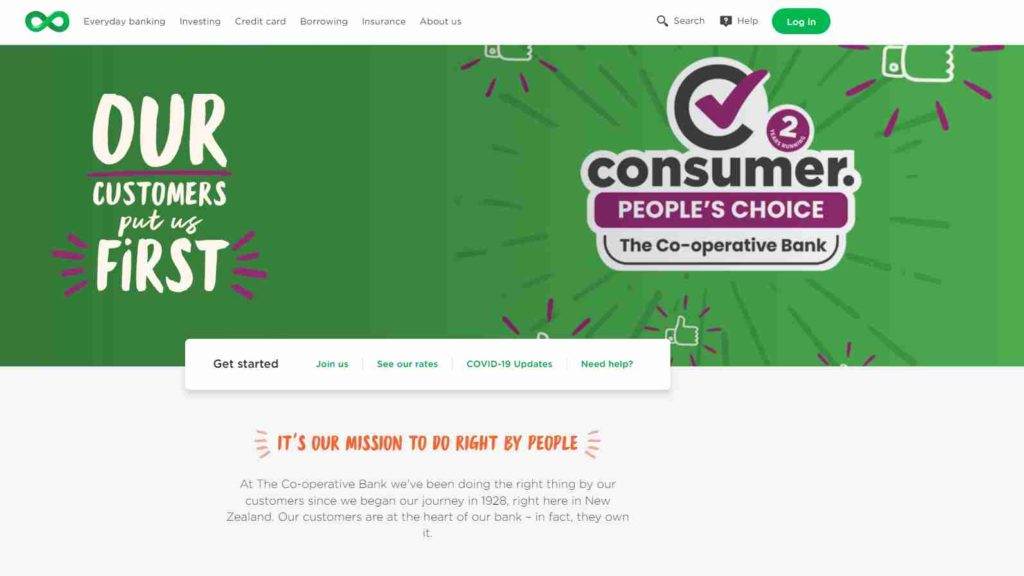
Co-operative Bank’s credit card presents an appealing long-term low interest rate with an annual fee of $20. The deal entails an enticing 0% interest rate for the initial 6 months, which later adjusts to 12.95%. The annual fee amounts to $20, paid in $10 increments every six months. There is no balance transfer fee, and the monthly payments must exceed the minimum requirement, which is either 3% of the outstanding balance or $10, whichever is higher.
To make use of this credit card, certain factors must be considered. Firstly, you cannot transfer a balance from another The Co-operative Bank card. Additionally, the credit limit must be at least $1,000, and the balance transfer amount cannot exceed 80% of the credit limit, with a minimum of $100 for balance transfers. After the 0% interest period ends, any remaining transferred debt will incur a 12.95% interest until it is fully paid off.
Furthermore, it is essential not to use the card for cash withdrawals or new purchases, as the interest rate for these transactions stands at 12.95%. While you can only perform one balance transfer from another card, it is possible to consolidate balances from multiple cards into a single transfer.
2. Westpac Fee Free Mastercard
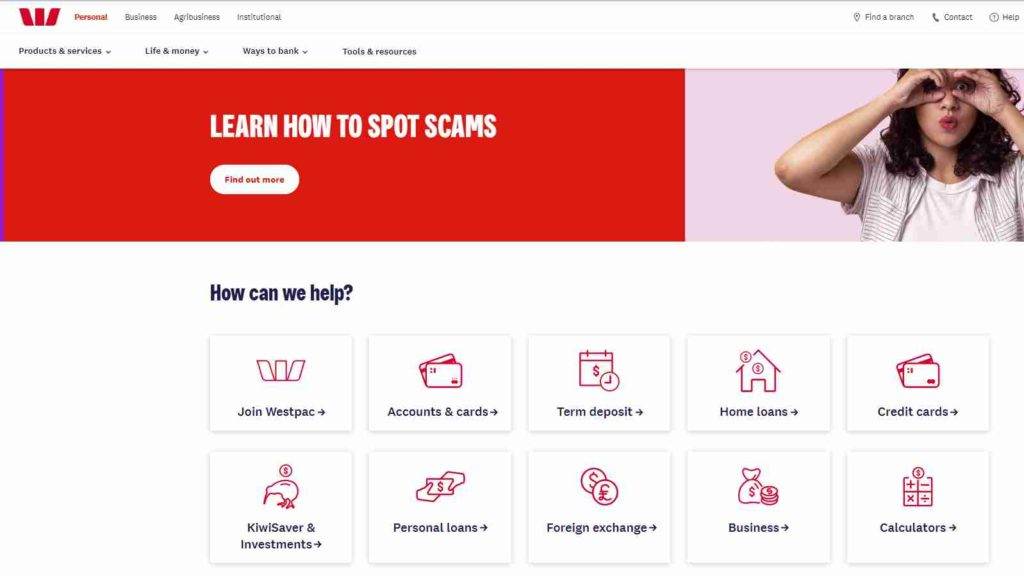
Westpac Fee Free Mastercard presents a plethora of benefits without any burdensome charges. With no annual fees, no foreign transaction fees for overseas purchases, and a highly favorable low-interest rate of 12.90% per annum, it’s a compelling choice for financially savvy individuals.
Here’s a summary of the deal’s key features: Firstly, there are no annual fees, providing cardholders with the freedom to enjoy its perks without worrying about extra costs. Secondly, the absence of overseas foreign exchange fees ensures that travelers can make purchases abroad without incurring additional expenses. Thirdly, the credit card offers a competitive interest rate of 12.90% per year, which is considerably lower than many other options in the market.
Moreover, this card presents an attractive balance transfer offer, with a fixed rate of 5.95% for the entire duration of the balance. This enables users to consolidate their debts and manage them more effectively. However, it’s essential to note that monthly payments must exceed the minimum requirement, which is either 2% of the outstanding balance or a minimum of $5, whichever is higher. Responsible credit management will ensure that cardholders can fully benefit from this exceptional offering.
3. ASB Visa Light
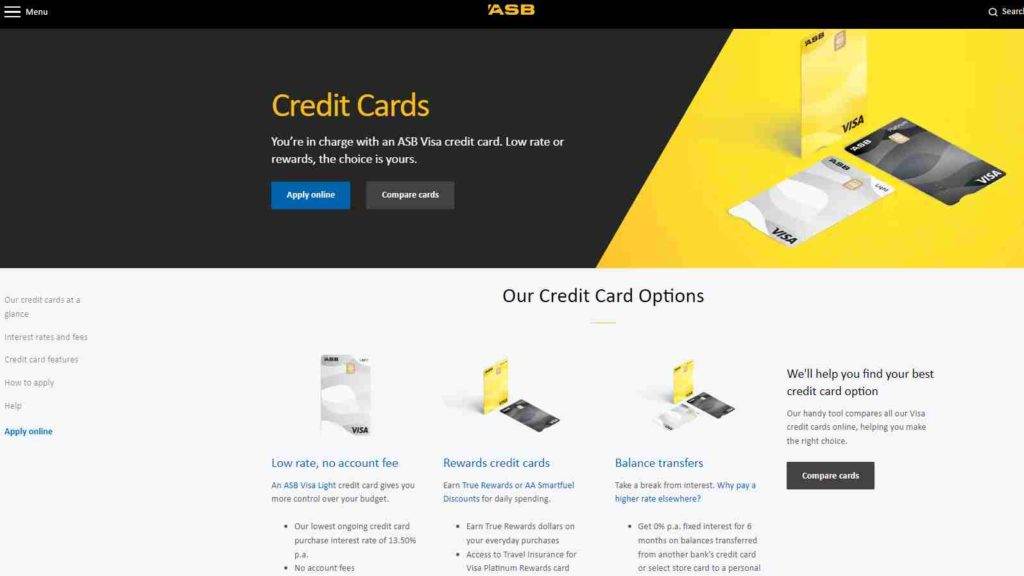
ASB Visa Light is presenting a compelling 0% balance transfer opportunity, allowing you to clear your outstanding balance and enhance your financial practices. The deal offers an interest-free period lasting six months, during which you can diligently work towards paying off your debt without incurring any interest charges. However, it’s crucial to take timely action and initiate the balance transfer within the initial 30 days to secure this advantageous 0% interest period. It’s important to note that balance transfers from other ASB cards are not permitted.
The terms of this deal are quite attractive. For the first six months, the interest rate remains at a favorable 0% per annum, offering significant financial relief. Beyond this grace period, the interest charge will rise to 13.50% per annum, necessitating careful financial planning to avoid high interest costs. Additionally, there is no annual fee associated with this offer, which is another appealing aspect.
Moreover, ASB is providing a window of opportunity for interest-free purchases over $1,000 for six months. This means that if you need to make sizeable purchases, you can take advantage of this interest-free period to manage your expenses efficiently.
4. ANZ Low Rate Visa
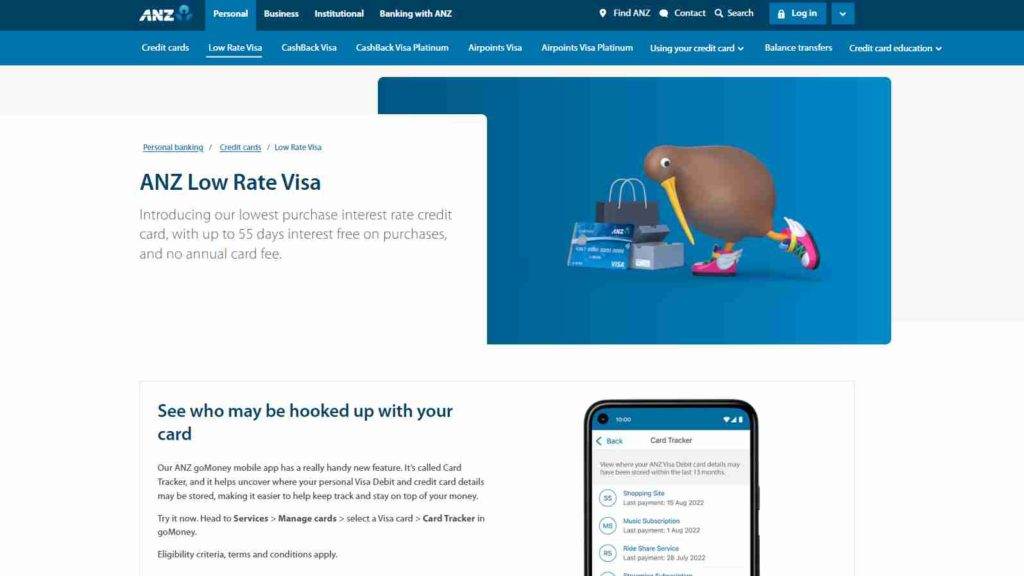
ANZ Low Rate Visa presents an appealing offer for those seeking to manage short-term debt through a balance transfer, and the first-year annual fee is waived. To make the most of this opportunity, the balance must be settled within 24 months, or else a 9.95%* interest rate will apply to any remaining balance.
The deal entails an initial interest rate of 1.99% for a duration of 24 months, after which it reverts to 12.90%*. During the first year, there is no annual fee, but subsequently, an annual fee of $35 will be charged ($17.50 every six months).
When initiating the balance transfer, no additional fee is imposed. However, it is crucial to effectuate the transfer within the first 30 days to avail of the 0% interest period. Note that transferring a balance from another ANZ card is not permitted.
Once the 0% interest period concludes, any remaining transferred debt will be subjected to a 9.95% interest rate until it is completely paid off. It’s important to avoid using this card for cash withdrawals or purchases, as new purchases will also incur a 9.95% interest rate.
Best Travel Benefits Credit Card
5. american express airpoints platinum.
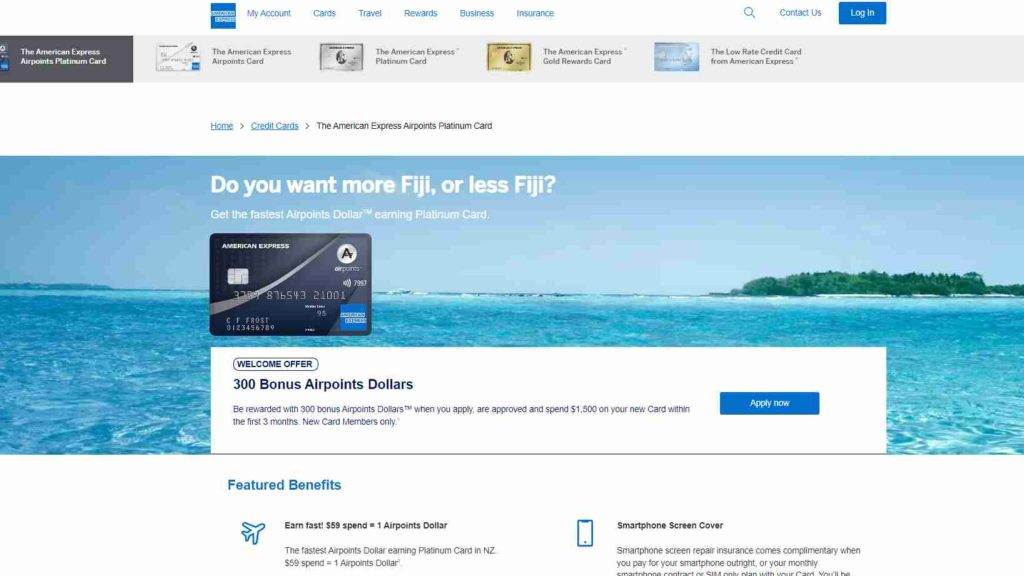
American Express Airpoints Platinum comes with a $195 annual fee but offers a plethora of valuable features. Cardholders can explore the detailed review of this credit card to learn more about its benefits. One of the significant advantages is the ability to use Airpoints Dollars for various purposes such as gifts, food and beverages, shopping at Mitre 10 and other hardware stores, flights, and numerous other options. Additionally, new applicants can enjoy a sign-up bonus of 300 Airpoints Dollars after being approved and spending $1,500 on the card within the first three months, effectively covering the membership fee for at least the initial year.
This credit card stands out with its high earning rate of Airpoints Dollars, approximately 1.70 for every NZ$100 spent, making it an attractive choice for those looking to grow their Airpoints balance each month. Moreover, cardholders benefit from a range of useful insurance perks, including coverage for rental cars and international travel, which could potentially save them hundreds of dollars. Notably, the American Express card is widely accepted across New Zealand, including all major supermarkets and retailers.
The card’s additional perks include mobile phone screen insurance for those who purchased their phone with the American Express card, as well as a notable discount on the Koru Club membership. In conclusion, the American Express Airpoints Platinum is deemed as one of the top credit card choices available, appealing to a wide range of households in New Zealand.
6. Kiwibank Air NZ Airpoints Platinum Visa
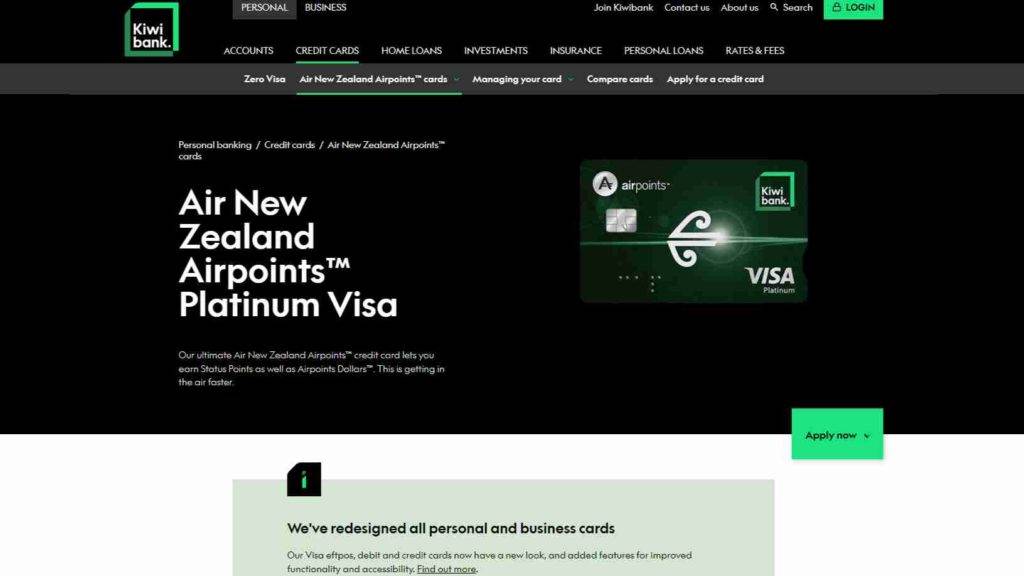
Kiwibank Air New Zealand Airpoints Platinum Visa card being discussed here is widely accepted and offers certain benefits, but it comes with a significant annual fee and a lower Airpoints earning rate compared to the AMEX Airpoints Platinum card. While the AMEX card earns 1 Airpoints Dollar for every $59 spent, this Visa card only earns 1 Airpoints Dollar for every $115 spent. This discrepancy makes it a high-fee platinum-level option, which might not be the best choice for those looking to maximize their Airpoints rewards.
The card’s deal includes an interest rate of 20.95% p.a. and an annual fee of $180. To maintain the account in good standing, monthly payments must exceed the greater of either 5% of the balance owing or $10. Additionally, using this credit card to pay for travel expenses provides complimentary overseas travel insurance, which can be beneficial for frequent travelers.
Another feature of this card is the Status Points it offers. For every $200 spent, the cardholder earns 1 status point, which aids in reaching different tier levels such as Silver, Gold, and Gold Elite. If a total of $45,000 is spent within a year, the cardholder will earn 225 Status Points. While this is half the number required to reach the Silver tier, it’s essential to note that 50% of the status points needed for tier progression must be earned on Air New Zealand, Star Alliance, or other Qualifying flights.
Best Rewards & Cashback Credit Cards
7. american express gold rewards card.

American Express Gold Rewards Card is a one-of-a-kind credit and rewards card in New Zealand, offering a delightful fusion of dining benefits and enticing rewards. Applicants can choose between a stylish pink or gold metal card during the application process.
With this card, dining enthusiasts are in for a treat. Each year, cardholders receive a $200 free statement credit when they dine at selected restaurants affiliated with American Express across the country. By spending over $100 on a single bill, $100 will be credited back to their statement. This dining credit is available twice a year, resetting every six months.
The rewards program is equally impressive, with cardholders earning 2 Membership Reward Points for every $1 spent. For those who spend approximately $25,000 annually, a generous reward of 50,000 Membership Reward Points awaits. These points can be converted into 333 Airpoints Dollars, $375 of travel credit (which can be booked through American Express Travel), or roughly $250 credit toward card expenses (equivalent to 52,000 Membership Reward Points).
It’s important to note that the American Express Gold Rewards Card comes with an interest rate of 19.95% per annum. However, customers enjoy a comfortable interest-free period of 55 days. An annual fee of $200 is billed yearly.
8. SBS Visa
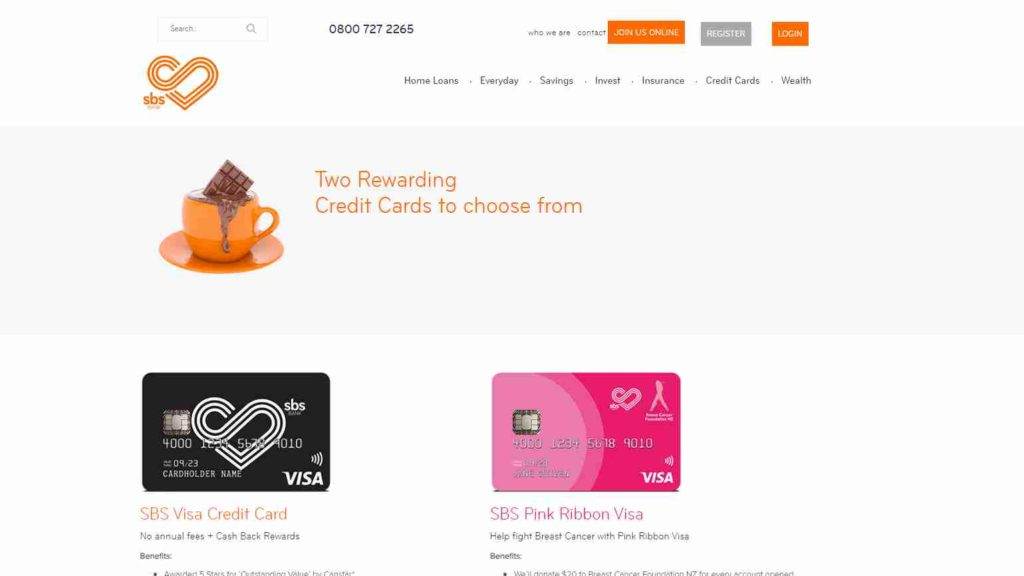
SBS Visa is a unique credit card that stands out for being the only one offering cashback to its users. With this card, you have the opportunity to receive a cashback of 67 cents for every $100 spent, providing a little financial benefit with your purchases. However, it’s important to consider some essential aspects of this card before applying.
One key factor to keep in mind is the relatively high-interest rate of 18.50% per annum. If you struggle to pay off your monthly balance in full, this higher-than-average interest rate could potentially lead to significant costs in interest charges, making it less favorable for those who may carry a balance from month to month.
Nevertheless, the card does come with a few attractive features. It provides a reasonable interest-free period of 55 days, allowing you to make purchases without incurring interest as long as you clear your balance within that period. Additionally, you can earn cashback rewards of $1 for every $150 spent on the card, which can add up over time.
It’s important to manage your credit card responsibly and make monthly payments above the minimum amount required, which is either 5% of the closing balance or $10, whichever is greater. This helps you avoid falling into a cycle of debt and maintain a healthy financial standing.
9. TSB Platinum Mastercard
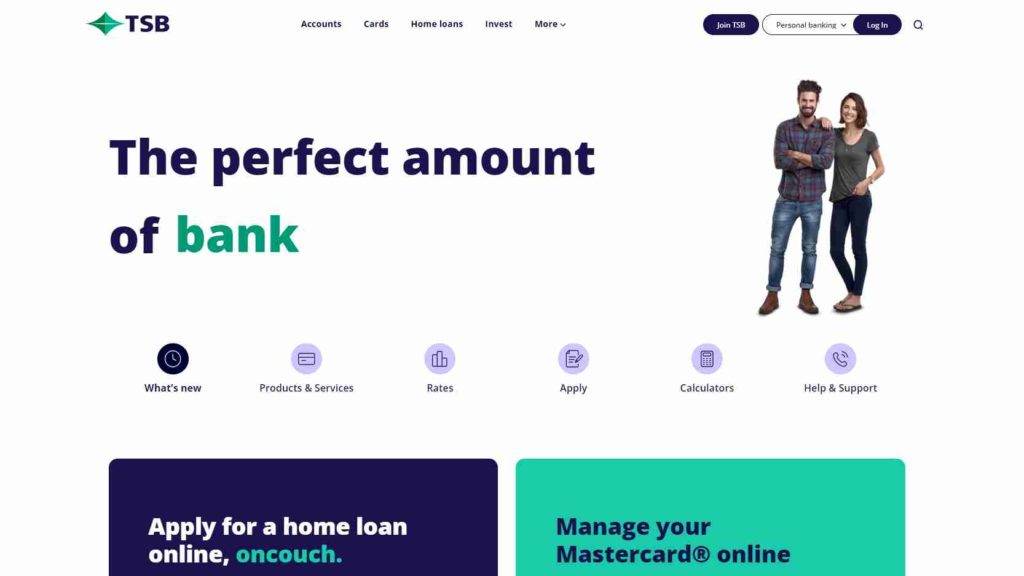
TSB Platinum Mastercard , a top-tier credit card tailored to cater to your premium needs. This exclusive card provides cardholders with exceptional benefits, making it an attractive choice for savvy consumers.
With the TSB Platinum Mastercard, you can earn $1 cashback for every $70 spent, translating to an impressive 1.42 cents back for every dollar spent. This generous rewards program ensures that you can get a little something back with every purchase you make.
In terms of interest rates, the card offers a competitive 20.95% per annum rate. However, with the added advantage of 55 interest-free days, you have the flexibility to manage your payments effectively without incurring any interest during this grace period.
The perks don’t stop there. Alongside the cashback rewards, the TSB Platinum Mastercard provides several valuable features. Cardholders can take advantage of travel insurance and purchase protection, safeguarding your purchases and ensuring peace of mind during your trips. Additionally, a standout benefit is the Mobile Phone Protection feature, which offers insurance coverage against accidental damage or theft when you pay your monthly mobile phone bill using the card.
To maintain your card’s benefits, it is essential to make monthly payments that exceed the minimum requirement, which is either 5% of the closing balance or $10—whichever is greater.
10. ASB VISA Rewards

ASB VISA Rewards , a credit card program that offers an array of enticing benefits for Kiwis looking to make the most of their spending. While some may find the allure of extravagant rewards like Samsung phones appealing, the truth is that earning such rewards requires an impractical amount of spending – $300,000, to be exact. Instead, the focus should be on the more attainable yet equally rewarding options.
With ASB VISA Rewards, Kiwis can earn 1 “True Rewards Dollar” for every $150 spent or even better, 1 for every $75 spent at Mobil stations. These True Rewards Dollars accumulate quickly, and for every $150 spent, you earn $1 in rewards value, equivalent to a 67 cents return for every $100 spent. It’s worth noting that these rewards can’t be used to directly offset your credit card bill but can be redeemed at various partner stores, opening up a world of enticing possibilities.
This credit card comes with a competitive interest rate of 20.95% p.a. and an annual fee of $40, billed conveniently at $20 every six months. To make the most of the rewards, monthly payments must exceed the minimum threshold, which is either 3% of the balance or $10, whichever amount is higher.
FAQ’s
What is a credit card, and how does it work in nz.
A credit card is a financial tool that allows you to borrow money from a bank or financial institution for purchases. In NZ, you can use it for online and in-store transactions, paying bills, and withdrawing cash, with the balance payable monthly.
What are the benefits of having a Credit Card in NZ?
Credit cards offer various benefits in NZ, including convenience, reward points, purchase protection, and the ability to build a credit history for future financial opportunities.
How can I apply for a Credit Card in NZ?
To apply for a credit card in NZ, visit the website of the bank or institution of your choice and fill out the online application form, providing necessary personal and financial details.
What factors influence credit card approval in NZ?
Credit card approval in NZ is influenced by factors like credit score, income, employment status, existing debts, and credit history.
What is a credit score, and why is it important for obtaining a Credit Card in NZ?
A credit score is a numerical representation of your creditworthiness. In NZ, banks use it to assess your credit card application and determine your credit limit and interest rate.
How can I improve my credit score in NZ?
To improve your credit score in NZ, pay bills on time, maintain low credit card balances, avoid unnecessary credit applications, and regularly check your credit report for errors.
Are there any fees associated with Credit Cards in NZ?
Yes, Credit Cards in NZ may have annual fees, late payment fees, and foreign transaction fees. Review the card’s terms and conditions to understand the fees applicable.

Compare Credit Card Rewards
Latest in credit card rewards.

Banking & Insurance - August 12th
American Express Wins Canstar’s Most Satisfied Customers | Rewards Credit Cards Award 2024
Congratulations to American Express, the winner of Canstar’s award for Most Satisfied Customers | Rewards Credit Cards. How do you like your credit card rewards? Across credit cards, the rewards on offer break down into two…
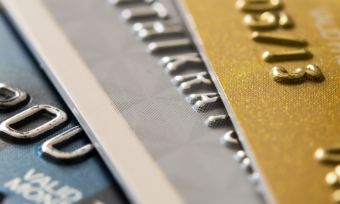
Credit Card Rewards - March 27th
NZ's Best Credit Cards
Bank of the Year | Credit Cards Congratulations to TSB, the winner of Canstar's award for Bank of the Year | Credit Cards. Each year, Canstar's expert research team evaluates all the major credit cards on…
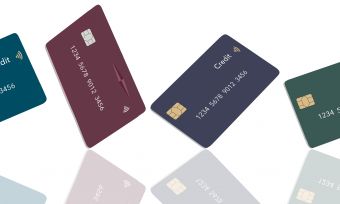
Credit Card Rewards - March 26th
NZ's Best Rewards & Airpoints Credit Cards
If you pay off your credit card in full each month, a rewards credit card is a great way to earn freebies. Cash, rewards points and Airpoints are all on offer, and the more you spend…

Credit Card Rewards - February 12th
Responsible Borrowing: the Difference Between Good and Bad Debt
There’s a time to borrow and there’s a time to save. In many respects, it’s a truthful adage. People have always borrowed money. Governments have always borrowed money. Used wisely, debt can be a tool to…
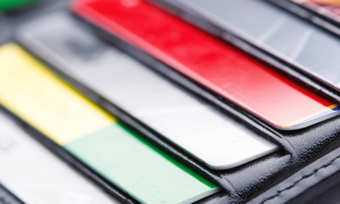
Credit Card Rewards - December 18th
What is Flybuys and is it Worth it?
What is Flybuys? Flybuys is the largest loyalty program in New Zealand, boasting over 2.4 million members. Members earn Flybuys by shopping with partnered retailers or by completing surveys and reviews. These Flybuys can then be…
Recent Winners
View Credit Cards Awards
View Most Satisfied Customers Award for Credit Cards
View Most Satisfied Customers Award for Rewards Credit Cards
Helpful Credit Card Rewards Information
What are Credit Card Rewards?
Credit card rewards are, as the name suggests, rewards for making frequent credit card purchases . The four main types of credit card rewards are
- Frequent flyer
- Merchandise
- Instant discounts
You can compare credit cards rewards with Canstar’s comparison tool , where you can filter the results to show the credit card features you’re interested in.
- Cash back rewards:
Getting cash back is a reward that would appeal to just about anyone. These cards reward you with a refund of a certain percentage (usually from 0.5% – 1%) of your spending. If you are comfortable using the credit card for most of your spending to maximise your cash back rewards, this might be a good option.
- Frequent flyer rewards:
Cardholders earn points towards flights, travel insurance, concierge services, and merchandise from the card’s partner airline. You can usually also earn bonus points for buying your flights on your rewards credit card.
Obviously, these cards are popular with people who fly frequently for work or leisure, but they’re also useful for people who save up their points for years towards a long-distance or around-the-world trip. These cards are less useful for people who spend only $12,000 or less per year on their card, as they will probably not accumulate enough points to make the rewards program worthwhile.
- Merchandise rewards:
Merchandise reward cards may be appealing for shopaholics! Merchandise cards offer rewards you can redeem at stores or outlets you love. Merchandise covers a wide range of rewards including tickets to sports events or concerts, gift cards, restaurants, holiday accommodation, or fashion items.
- Instant discounts:
Unlike the other types of rewards, instant rewards are benefits that you receive automatically at point of sale, such as an exclusive discount and 2-for-1 offers.
Interest rates and fees for credit card rewards
Rewards cards can potentially charge a much higher interest rate than low-rate, no frills card s .
So, if you don’t spend a lot on your card or you find you can’t pay it off in full each month, a rewards card might just be an incentive to spend more than you can afford! On the other hand, if you do spend a lot and pay it off every month, you could do quite well out of the right rewards card.
Common credit card fees are the standard payments you can expect to pay with any of the credit cards you choose. These fees include:
- Annual fee: charged for administration of your line of credit. Some cards come with no fees, while ones that offer premium extras, cashbacks and rewards can charge hundreds of dollars per year.
- Additional cardholder fee: charged to issue a second person with a card linked to the rewards credit card account. Fee costs can vary greatly.
- Balance transfer fee: charged to transfer the balance of another credit card onto your rewards credit card. It may be charged as a percentage of the amount you transferred.
- Cash advance fee: charged when you use your credit card to get cash out from an ATM, buy foreign currency, or buy travelers cheques.
- International transaction fee: charged to process purchases you make while overseas, or purchases made in a currency other than New Zealand dollars. These fees are a percentage of the purchase price, so the cost adds up quickly.
- Late fee: charged if you do not pay the minimum amount due on your monthly bill. Instead of waiting for your bill to pay it, you can set up a direct debit automatic payment with the bank for the minimum amount every month.
- Over-limit fee: charged when you spend more than your credit card limit.
- Non-bank ATM fee: charged by your bank when you use an ATM from a different bank to make a balance enquiry or cash withdrawal.
- Replacement card fee charged if your card is lost or stolen and must be replaced with a new card.
How to choose a credit card rewards program
The right rewards credit card for you will depend on your spending habits and the way you use your credit card. While Canstar can only provide general advice on this, we research a number of credit cards from different providers to help guide the decision process.
When you’re comparing credit card rewards, to find the ideal one for you, it pays to consider multiple factors, including:
- What type of reward you are most likely to use
- How much you spend per year on your card
- Whether the card costs are less than the rewards
If you use your credit card frequently and pay off your entire bill each month, a traditional or points-based rewards card might be worth looking at. Some tips include:
Choose a reward you’ll actually use.
It’s not all about frequent flyer points. Different cards offer different rewards in different forms and sizes, and some may be harder for you to redeem than others. If the rewards on offer for a card aren’t going to provide you with a material benefit, look for something else. Many rewards cards are now also universally-friendly, as they offer rewards points that can be redeemed in a wide variety of ways and for different types of rewards.
Choose a card that suits your spending level.
Choose a rewards credit card that matches the amount of money you spend on credit every year. You can figure out your spending profile from your monthly credit card bill.
You can figure out your spending profile from your monthly credit card bill – is it for $1000, $2000, $5000, or $10,000 and up?
Rewards cards can give you incentive to spend more on credit, but remember to be disciplined. We don’t want to add to the massive amount of credit card debt in New Zealand. If you don’t use your credit card much or you don’t actually need one, then signing up for a rewards credit card wouldn’t be worth it for you and could cause unnecessary debt.
Choose a card where the rewards outweigh the cost.
When it comes to an annual fee , you can work out whether the fee is worth it by calculating the net rewards return from the dollar value of points earned each year, and ensuring it is more the annual fee.
Annual fee: You can work out whether the fee is worth it by calculating the net rewards return from the dollar value of points earned each year, less the annual fee.
For example, let’s say you spend $24,000 in a year and earned 24,000 points. Divide the number of points earned by the number of points needed to earn $1 back. You want a high ‘earn rate’ so you can build points quickly, but those points need to be worth something. If your card gives you 150 points to the dollar, you’ve earned $160 in rewards that year. Then subtract your $100 annual fee, and you’re left with $60 of extra rewards earned that year. However , if you only spent $12,000 that year, that only earned $80 in rewards and didn’t cover the $100 annual fee.
Interest rate: The higher interest rates for rewards cards can be dangerous for non-disciplined spenders. If you’re paying any interest, the card quickly gets far too expensive to be worth it. You want to know you can pay off the balance before any interest gets charged.
Look for good bonus offers.
There are a few ways to make the most of the free benefits on a rewards credit card.
Look for bonus offers to boost your points balance. Many cards offer a lump sum of bonus points just for signing up, often with conditions or a shorter expiry time attached.
Also, remember to use any helpful extras that come with the card, such as free travel insurance or concierge services. Check that cards with these extra benefits don’t have a higher annual fee.
Certain cards earn more points from certain partner businesses. You might have a higher earn rate when you spend at the supermarket than at service stations or restaurants. Know where your card will be the most valuable to you.
Check for silent points killers.
Points redeeming: Some cards make it more difficult to redeem rewards than others. For example, you might have saved up enough frequent flyer points for a business-class flight overseas, but if the airline doesn’t allocate any frequent flyer seats on the flight you want, the points are worthless.
Points capping: Some cards have a cap on the number of points you can earn in a year. Make sure that the limit is not so low that it stops you from getting any value out of the card.
Points expiry: Choose a card where points don’t expire in a hurry. It would be heart-breaking to save up 500,000 points for a holiday and then see them disappear before you book the flight. Thankfully, many cards have rewards points that do not expire.
Credit Card Rewards glossary of terms
Please note that these are a general explanation of the meaning of terms used in relation to credit card rewards. Your bank or financial institution may use different terms, and you should read the terms and conditions of your credit card carefully to understand all rewards, features, fees and charges, and interest rates that may apply to your card.
Annual fee / annualised fee : charged for administration of your line of credit. Annual fees vary – some credit cards don’t charge an annual fee, while the American Express Platinum Card has an annual fee of a substantial $1250.
Automatic transfer: A system where a bill is paid by one bank automatically transferring money into an account when the bill comes due. Also known as direct debit.
Auto-redemption: A system you can set up with your provider where every time you reach a certain number of points, they are automatically redeemed in the method of your choice.
Average daily balance: The average daily balance of your card is determined by adding up all balances during the month and dividing the total sum by the number of days in the month. With most lenders, the annual interest rate is then applied to that “daily” amount.
Balance transfer: Transferring the outstanding balance of one credit card to another card, usually one with a better (lower) rate.
Balance transfer fee: A fee charged when you make a balance transfer. It may be a flat fee or a percentage of the amount you transfer.
Bankruptcy: This is when someone’s debt problems become so serious that they are unable to pay their existing debts and bills. They can apply to a court to be declared bankrupt, and any assets or savings they have can be used to pay off their debts. They can then wait a certain time period to have that bankruptcy removed from their record, or apply for it to be removed earlier.
Big spender: Credit card users who spend a lot on their cards every month and always pay off the full balance. Rewards credit cards are useful for these cardholders because they spend enough to earn a significant amount of rewards points.
Cash advance: Withdrawing cash from a line of credit. Usually incurs a cash advance fee and/or a higher interest rate.
Cash advance fee: A fee charged when you use your credit card to get cash out from an ATM, buy foreign currency, buy travelers cheques, or pay a gambling debt. The fee can be a flat dollar amount or a percentage of the amount withdrawn.
Caveat emptor: Latin for “let the buyer beware”. In financial situations, this phrase means that a buyer should be careful to examine a product?s terms and conditions, before signing up for the product.
Credit limit: The maximum amount you can spend using your credit card before having to pay off some of the balance.
Credit report or credit history: A report from a credit agency that contains a history of your payments on current and previous credit cards and loans. Banks and other lenders use your credit report to decide how likely you are to repay a future debt and whether or not to lend money to you.
Credit rating or credit score: A numerical score that represents your credit-worthiness, based on your credit repayment history. The score is based on whether you pay your bills on time, your current level of debt, the types of credit and loans you have, and the length of your credit history. Your credit rating and credit report are used by banks and lenders when deciding whether or not to lend money to you.
Debit card: Also known as a bank card or a cheque card. Allows you to access the money in your savings or checking account to make purchases, and requires that you enter your PIN number.
Default: When a cardholder fails to make the minimum required payment on their credit card bill, loan, or other line of credit. Defaults are a serious black mark on your credit report and negatively affect your credit rating.
EFT: Electronic Funds Transfer. The electronic transfer of money between accounts by ATMs, home computers and EFTPOS machines.
EFTPOS: Electronic Funds Transfer at Point Of Sale. Usually refers to a small machine that merchants use to receive payments from a customer’s credit card, debit card or gift card.
Everyday spender: Credit card users who use their credit cards for everyday purchases and pay off their balances each month.
Full balance: The entire amount owing on your card that month, including any purchases made during the month, any amounts unpaid from previous bills, and any interest or fees charged.
Habitual spender: Credit card users who keep a revolving debt on their credit card and don’t manage to pay it off each month.
Interchange fee: A fee charged by your bank for a merchant’s bank to process a payment via your credit card.
Interest rate: The rate at which your outstanding balance increases per month if your bill is not paid in full.
Interest-free days: The number of days you have to pay your bill in full before interest is charged on the outstanding balance. It is the period of time between the date of a purchase and when the payment is due.
Introductory rate: An initial interest rate offered to entice new cardholders to sign up for a credit card. These rates usually begin low but revert to the standard rates after six months or so.
Merchant: Someone who sells goods or services to customers for payment.
Minimum interest charge: The minimum amount of interest you would be charged if you are charged any interest. For example, if your total interest charge is $0.75 but the bank’s minimum interest charge is $1.00, you will be charged $1.00.
Minimum payment: The number listed on your bill as the minimum your bank requires you to pay off your credit card balance for that month.
Occasional spender: Credit card users who only spend in splurges or on impulse (holidays, emergencies) and then spend months paying the balance off.
Ombudsman: If you have a dispute with your bank and haven’t been able to resolve it through their internal complaint resolution process, you can contact the Insurance and Financial Services Ombudsman in New Zealand on 0800 888 202. It is a free and independent service that resolves disputes with banks and other financial institutions.
Overdraft fee: An overdraft occurs when you make any type of payment without having that amount of money in your account. T he bank will extend credit up to a maximum amount, the overdraft limit. Interest is charged daily on the balance of your overdraft amount.
Over-limit fee: A penalty fee charged to you for exceeding the credit limit on your credit card.
Penalty fees: Fees charged if you violate the terms of your cardholder contract. Over-limit fees are an example of a penalty fee.
Pre-approval: An initial notification that a customer is likely to be approved for a certain credit limit if they apply for that type of credit card. This is based on the bank’s information about their credit history as opposed to their official credit report, so it does not guarantee the customer will actually be approved if they apply.
RBNZ cash rate: The overnight interest rate that the Reserve Bank of New Zealand offers financial institutions to settle-up on inter-bank transactions.
Revolving account: An account where repayments are not fixed to a certain number of payments of a certain amount, and the account stays open even if the full balance is not paid off every month. Credit cards are the most common type of revolving account.
Rewards: Benefits that come from using a rewards credit card, in proportion to the amount of money spent. Rewards come in four main types: cash back, frequent flyer miles, merchandise (shopping vouchers), and instant or general rewards.
Switching: Changing from one product to another with the same financial institution, e.g. switching from a rewards credit card to a savings account with a debit card attached.
Universal default: Where one financial institution treats a borrower as if they had defaulted with them because the borrower defaulted with a different institution.
Credit card products we research and rate
Read the Methodology document in our star ratings report to find out how we rate credit card providers.
Who offers credit cards in New Zealand?
- American Express NZ : American Express was founded in 1850 and issues the world’s largest number of credit cards.
- ANZ Bank NZ : ANZ has a long history, founded in 1835 in Sydney as the Bank of Australasia. Nearly one in two Kiwis have a banking relationship with one of the ANZ brands. They are New Zealand’s largest rural banker, serving 39% of rural Kiwis.
- ASB Bank NZ : The first Auckland Savings Bank was founded in 1847 “to serve the community and to help Kiwis grow”, and they now have more than 1.3 million customers. They boast a number of country-wide banking firsts: first internet banking site (1997); first no-branch bank (1997); first 7-day branch (1998); first to offer online share trading in both New Zealand and Australian share markets (1999); and first mobile internet banking (1999).
- Bank of New Zealand : Bank of New Zealand opened their first office in the 1860s in Queen St, Auckland, and acquired the account of the Central Government from the Union Bank. In the 1940s, they were the first bank in the country to open a mobile banking office in a caravan, and the first to begin granting personal loans.
- Gem : Gem is part of Latitude Financial Services, which looks after more than 2.5 million customers across New Zealand and Australia. The Gem Visa Card has been available in New Zealand since 2002.
- Kiwibank : Kiwibank is 100% New Zealand owned and you can find them in more than 250 PostShops nationwide. That’s probably why they have so many customers – 800,000, in fact. Kiwibank have previously won several Canstar banking awards.
- TSB Bank : TSB Bank opened in 1850 and has been proudly independent and New Zealand owned ever since.
- Westpac NZ : Westpac was established in New Zealand in 1861, beginning on the gold fields of Otago. They now serve over 1.3 million customers across the country. The predecessor of Westpac NZ, CBA New Zealand, was the first bank to lend money to women, with their “Yes, we do lend money to women” campaign in 1974.
- The Co-operative Bank : The Co-operative Bank was founded in 1928 as the Public Service Investment Society, but they have shaken off the shackles of their past and now offer banking to all Kiwis.
- Purple Visa Card : The Purple Visa Card is issued by SBS Money Limited – a brand of Finance Now. It offers l ong-term, interest-free finance at participating retailers .
Other credit cards articles and guides
Articles and Guides
What is a Credit Card and How Does it Work?
What’s the Difference Between Visa & MasterCard?
No Annual Fee or Low Interest Credit Cards: What’s Better?
How to Improve Your Credit Rating: 7 Steps
Choosing a credit card articles:
Best Balance Transfer Credit Cards
How to Choose a Credit Card for Your Spending Habits
Getting out of credit card debt:
Guide to Avoiding Hefty Credit Card Fees
Save Money and Protect Your Finances: 10 Steps
How to Keep on Top of Your Credit Card
Keen to Get Out of Debt? Here’s Your 11-point Plan
Quick Links
Travel money guide: New Zealand
Our guide will empower you to have the best combination of travel money when heading to new zealand.
In this guide
Travel card, credit card or debit cards?
These are your options for spending money in new zealand, compare travel credit cards, buying currency in the us, atms in new zealand, what should i budget for my trip to new zealand, find travel insurance for your trip to new zealand.
Travel money type
Compare more cards
Top picks of 2024
Since the Lord of the Rings, the land of the long white cloud has been growing in popularity as a destination for tourists. But you should know the best way to access New Zealand dollars — called the kiwi — when you’re there. Credit cards, debit cards, and cash are all accepted without issue.
A credit card will serve you best during your Tasman travels, particularly one that doesn’t come with foreign transaction fees. But debit cards and cash can still work perfectly well.
Our picks for traveling to New Zealand
40+ currencies supported

- 4.85% APY on USD balances
- $0 monthly fees
- Up to $100 free ATMs withdrawals worldwide
- Hold and convert 40+ currencies
Up to $300 cash bonus

- 0.50% APY on checking balance
- Up to 4.60% APY on savings
- $0 account or overdraft fees
- Get up to a $300 bonus with direct deposits of $5,000 or more
Free ATM transactions

- $50 waivable monthly fee
- 0% foreign transaction fee
- Securely move money domestically and globally
- 5 monthly out-of-network ATM reimbursements
- Free international HSBC ATM transactions
Visa and Mastercard are accepted almost everywhere — nearly 75% of all transactions in New Zealand are done with cards. Get cash over the counter with your debit cards or find a ATM.
Whether you’re doing a quick business trip or taking a long vacation, it’s smart to have a couple of ways to access your money. Travel-friendly debit cards will let you spend in New Zealand dollars, but most travel cards apply an international ATM withdrawal fee.
A credit card gives you access to an emergency line of credit and can be used for interest free purchases, and some cards offer extras like insurance as well. Choose a mix that suits your needs.
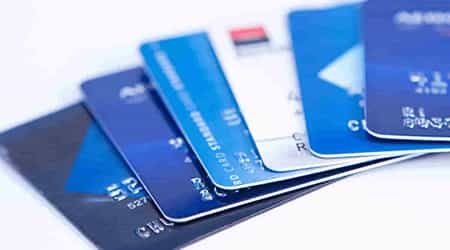
Using a credit card
Look for a card that doesn’t charge a foreign transaction fee, like the Capital One VentureOne Rewards Credit Card (Terms apply, see rates & fees ). Some credit cards also offer complimentary travel insurance as well as other travel benefits, including the ability to earn miles on purchases.
Finding the best card for your travel habits can save you a lot of money in the long run, so compare travel cards carefully before making your final decision.
- Protected by PIN and chip
- Accepted worldwide
- Some offer complimentary travel insurance
- Interest-free purchases when account is paid in full
- Emergency card replacement
- Cash advances can charge high interests and fees
- Higher spending limit (depends on your approved credit limit)
- Attracts an annual fee
Explore top debit cards with no foreign transaction fees and travel credit cards by using the tabs to narrow down your options. Select Compare for up to four products to see their benefits side by side.
- Credit cards
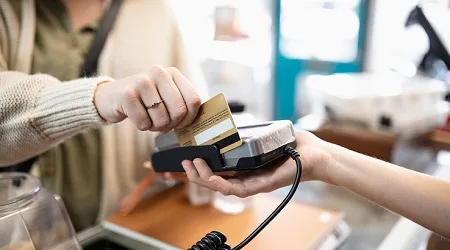
Using a debit card
A debit card is a great travel money choice for New Zealand. You’ll have access to cash each time you come across an ATM, without carrying lots of cash on you all at once. Because you’re spending your own money, you avoid interest charges. Find a card that waives the fee for international ATM withdrawals and doesn’t charge a monthly account keeping fee, like the kind offered by Betterment Checking .
- Tip: A debit card can be used to shop over the counter, online and for ATM withdrawals in New Zealand.
- Access to money at ATMs
- Debit cards will not incur an interest rate
- International ATM withdrawal fees may apply
- Currency conversion fees
- No emergency funds

Using a prepaid travel card
**Unfortunately, right now there are no travel cards in the US that allow you to load NZY.
Travel cards can lock in conversion rates once you load USD. Use it for purchases without worrying about rates each time you spend — debit and credit cards often charge 3% for each transaction.
- Ability to lock in the exchange rate
- Secured by PIN and chip technology
- Emergency card replacement and backup cards
- Easily reloadable via a secure online platform
- International ATM withdrawal fees, card issue fees and initial load fees may apply
- Reload fees could be high
- Some charge for inactivity fee
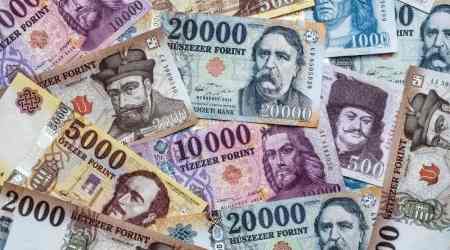
Paying with cash in New Zealand
Currency exchange offices charge a commission to do the exchange, and they also make money off a margin applied to the exchange rate.
You can always send your money to New Zealand ahead of time with a money transfer service and have it waiting to be picked up when you arrive.
- Greater payment flexibility
- Convenience
- Difficult to manage expenses
- Higher risk of theft

Using traveler’s checks
Traveler’s checks have been replaced by debit, credit and travel money cards. A cheaper way to get cash in New Zealand is to make an ATM withdrawal, especially if your card provider has a relationship with the bank of the ATM you use.
The main advantage of traveler’s checks is they can be replaced if lost or stolen.
- Security: You must present ID to cash them
- Availability to cash at banks
- Secure and can be easily replaced if lost or stolen
- Money back guarantee if you’re a victim of card fraud
- Cashing checks is subject to a commission
- Currency exchange rate varies over time
If you want to exchange your currency, have a look at these companies that can sell you foreign cash. Travelex has outlets at major airports and you can make an order online and collect the New Zealand cash before you get on the plane.
- American Express
- Wise (TransferWise)
You can bring the US dollar equivalent of $10,000 New Zealand dollars with you. If you take any more than this, you have to declare your cash when you pass through customs. You’ll get a better deal if you wait to get your money changed in New Zealand, even better if you make a withdrawal from an ATM rather than use a money exchange service.
Exchange rates using your card
When you use your credit card, debit card or travel card to make a purchase in New Zealand, the exchange rate set in place by your card applies to the transaction. When you use your card for over the counter purchases, you’ll get a rate which is a touch above the market rate. The same when you make a withdrawal from an ATM.
Refreshing in: 60s | Wed, Aug 21, 12:53AM GMT
Here are what some of the banknotes look like:
The main banks in New Zealand are:
- ANZ Bank New Zealand
- Bank of New Zealand
- Co-operative Bank
- Industrial and Commercial Bank of China (New Zealand) Limited
- Rabobank New Zealand
- Westpac New Zealand
You should have little issue finding a convenient ATM location during your New Zealand travels. Remember to use a card that doesn’t charge foreign ATM fees, like a debit card from Betterment Checking.
The opportunities for exploration and adventure opens up the possibility of blowing your budget. If you want to get around the country, you’ll need to rent a car — and it can be pricey. If you rely on busses or staying in one place, you can budget less than $50 a day. But for a more adventurous vacation, a realistic budget ranges from $130 to $350 a day. All prices are in US dollars.
Prices are for example purposes only.
Case study: Mike's experience

Mike goes skiing in Queenstown: The adventure capital of the world
Mike says Queenstown has the best skiing experience in New Zealand. The snow, the nightlife, the food and atmosphere are all top notch.
What are your travel money tips?
Mike says if you’re traveling by shuttle bus to the peaks, purchase the tickets in bulk. A single ticket costs $15, but there’s discounts for purchasing packs of 10 or 15 tickets at a time.
New Zealand offers travelers a wondrous land to explore, from ski fields to volcanic hot springs, there are plenty of things for the family to enjoy.
But with every journey comes and element of risk, which is why there is travel insurance to protects against far more than just health issues. Travel insurance covers the following:
- Trip cancellation
- Lost luggage
- Personal liability
- Lost travel documents
Don’t let your vacation turn into a nightmare, compare travel insurance policies today.

Kyle Morgan
Kyle Morgan is SEO manager at Forbes Advisor and a former editor and content strategist at Finder. He has written for the USA Today network and Relix magazine, among other publications. He holds a BA in journalism and media from Rutgers University. See full bio

Travel Card
Get our best rates on the award-winning travelex money card. manage your card via our app or online., buy currency, top up card.
Rate last updated Wednesday, 21 August 2024 12:41:20 PM NZST. Please note that these are the Travelex online sell rates.
[fromExchangeAmount] [fromCurrencyCode] New Zealand Dollar
[toExchangeAmount] [toCurrencyCode] [toCurrencyName]
Enter the card number of the Prepaid Card you would like to top up. The number of the Prepaid Card you are topping up must be the Primary Card Number and must have been originally purchased from Travelex.
Card number confirmed
Select the currency you would like to top up to your card
Enter how much you'd like to top up either in New Zealand Dollars, or in the foreign currency amount for the currency you have selected.
Save with the Travelex Money Card
An award-winning travel card that can be used wherever Mastercard is accepted, online or in-store at millions of outlets around the world, conveniently allowing you to tap & go worldwide.
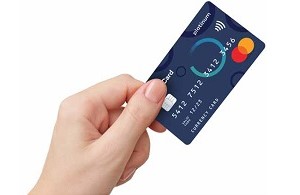
$0 Eftpos Fees
$0 atm fees 2, $0 currency conversion fees 3, $0 online shopping fees 3, the travelex money card, travel card foreign currency exchange rate, choose among 9 currencies available on the travelex prepaid travel card..
Copy for using AUD in other countries
A fee will be charged
List of european countries:
Features and Benefits: Why a Travelex Money Card?
UNLIMITED FREE overseas ATM withdrawals 2
Highly competitive exchange rates 1
NO fees when you buy online $0 Currency conversion fee ^
- 24/7 Global Assistance
Convenient Mobile App Download it here
Shop at millions of outlets wherever Mastercard is accepted
Exclusive offers with Mastercard Priceless TM Cities
No account or membership required
Buy the Travelex Money Card Online
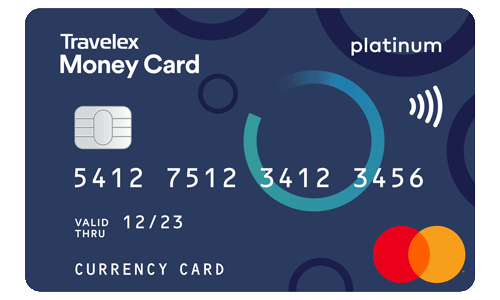
- Award winning global currency card
- Order online for next day collection in Travelex stores
- Or just walk in our store and get it in minutes
- No account and no membership required
Emergency Assistance
- Optional Additional Emergency card at checkout
Easy online ordering
- All you need is your passport** ( documents required when collecting )
- Order process takes between 5 and 10 minutes
** Check the required documents when collecting your card in store.
How our Travel Card Works
Order your travel card.
Order your Travelex Money Card and Additional Emergency card online or in-store
Get your travel card
Collect from a Travelex store near you
Home delivery
Delivered within 1 to 3 days
Download the App
Download the app from the Google Play and Apple App stores
Register for My Account
Simply activate your card by registering your account via the app or online
Manage and check your balance online and on your mobile
Exchange leftover currency
After your trip, exchange leftover money for another currency, transfer into your bank account or withdraw in-store or at an ATM.
Download the Travelex Travel Money App
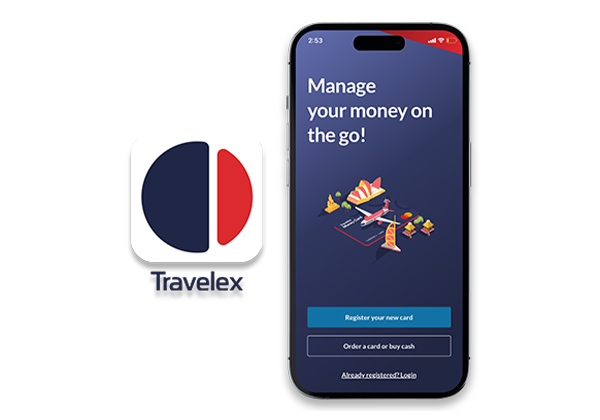
Experience the benefits
- Top up your Travelex Money Card wallet
- Check your balance and move funds between currencies
- Instantly freeze and unfreeze your card
- Reveal your PIN and card details for online shopping
The app requires Android 8.0 and up or iOS 14.0 or later. Compatible with iPhone, iPad and iPod touch.

Fees and limits
NO fees online
Withdraw daily up to NZ$3,000 (or currency equivalent)
Maximum Card limit of NZ$75,000
Free initial and replacement card
NZ$, AU$, US$, GB£, EU€, CA$, HK$, SG$, JP¥ .
*The currencies available may vary from time to time. Before you make a decision to acquire the card, please check with the Distribution Outlet or on this page.
Load/reload in NZD: the greater of 1.0% of the initial load/reload amount or NZD$10.00. Load/reload in other currencies: zero.For example, for a Distribution Outlet charging a 1.0% initial load fee, if you purchase a Travelex Money Card and load NZD$800, you would be charged (NZD$800 x 1.0%=NZD$8), unless a minimum fee of NZD$10 applies.
This fee is set and charged by Mastercard Prepaid Management Services.
FREE Some ATM operators may charge an additional withdrawal fee.
- Charged at the start of each month if you have not made any transactions on the card in the previous 12 months
- Unless your card is used again, or reloaded, this fee applies each month until the card is closed or the remaining card balance is less than the inactivity fee.
NZ$4.00 per month
Charged when you close or Cash Out your Travelex Money Card. This fee is set and charged by MasterCard Prepaid Management Services.
This is applied when you move your funds from one currency to another currency, or when you request a Cash Out to close your Travelex Money Card and you have funds in a foreign currency
At the then applicable retail foreign exchange rate determined by us. This rate reflects MasterCard Prepaid Management Service’s cost price plus a margin determined by MasterCard Prepaid Management Services. We will notify you of the rate that will apply at the time you allocate your funds from one currency to another and this rate (inclusive of the margin) may be less favourable than the foreign exchange rate for Online reloads where you allocate funds in a foreign currency.
Applied when a purchase or ATM withdrawal is conducted in a currency either not loaded or sufficient to complete the transaction and the cost is allocated against the currency/ies used to fund the transaction
MasterCard® rate plus 4.00% of the transaction value. The MasterCard rate is the exchange rate determined by MasterCard to be their wholesale rate or the government mandated rate in effect in the day the transaction is processed by MasterCard.
At the then applicable retail foreign exchange rate determined by us. This rate reflects MasterCard Prepaid Management Services’ cost price plus a margin determined by MasterCard Prepaid Management Services. For online reloads we will notify you of the rate that will apply at the time you book your transaction (further terms and conditions apply and will be provided to you at that time).
- Initial purchase: NZ$250 or currency equivalent
- Top-ups: NZ$100 or currency equivalent
The maximum amount you can load on the card at the time of the initial online purchase is NZ$10,050 equivalent.
(i) to a maximum of NZD10,050.00 per single top-up; and (ii) to a maximum of NZD10,050.00 per top-up within 24hrs; and (iii) to a maximum of NZD20,000.00 top-up within 21 days. NZ$20,000 or currency equivalent
Some ATM operators may set their own withdrawal limits which may be lower than this limit.
NZD$3,000 or currency equivalent
NZD$15,000 or currency equivalent
NZD$75,000 or currency equivalent
Some financial institutions may set their own withdrawal limits which may be lower than this limit.
NZD$400 or currency equivalent
NZD$0.00 (No overdraft facility available)
Fees & Limits
Terms & conditions, other ways to get foreign currency, all the easy options to access foreign currencies with travelex.

About Travelex Money Card online and in-store
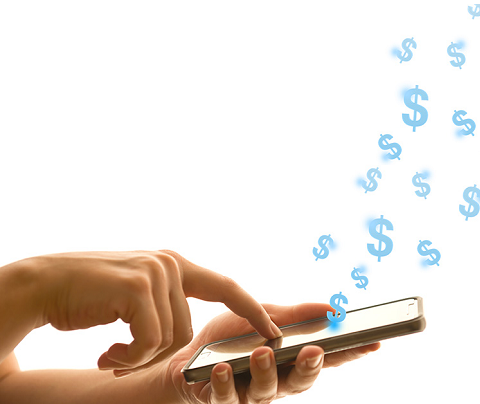
Money Transfer
Transfer money in-store to the world

All you need to know getting foreign cash with Travelex
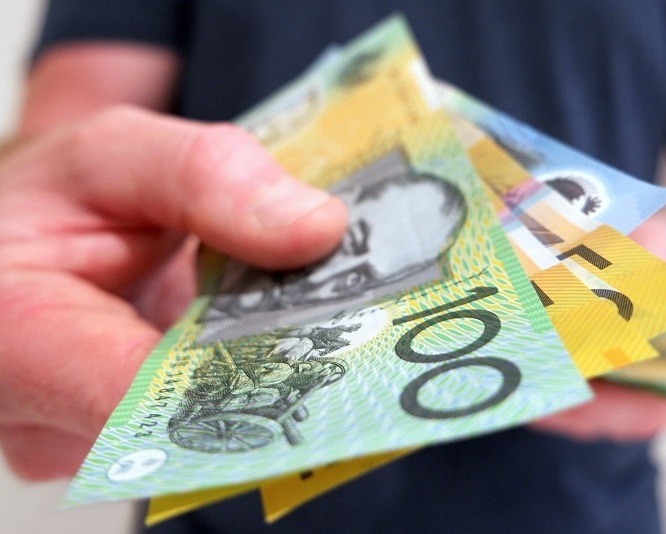
Get foreign cash from an ATM in New Zealand
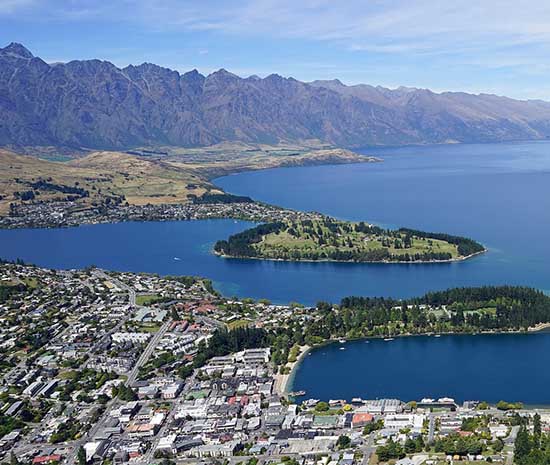
Buying Tips
Flexible options and tips when ordering with Travelex

Track Foreign Currencies Rate
Receive an alert when your foreign currency has reached your desired rate
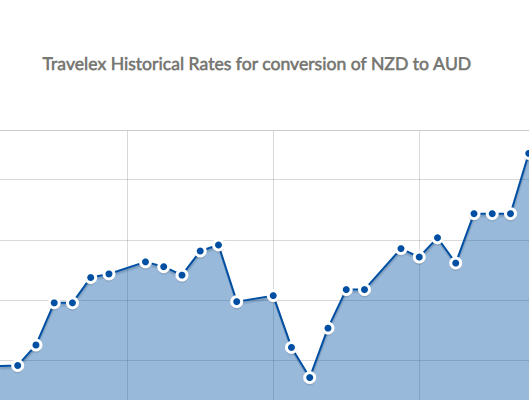
Historical Rates
Check out current and historical NZD to FX Travelex rates
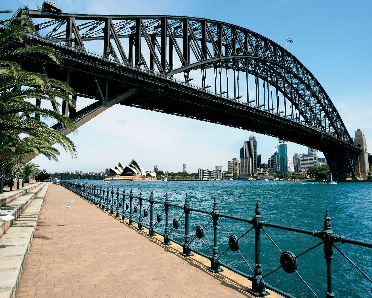
- Find a Store
Purchase cash, a Travelex Money Card or conduct a Money Transfer in-store
Travelex Travel Card Currency Information
Travel card faq links.
Getting Started
Fees and Limits

Travel Card FAQs
You can only hold one card in your name at any one time.
An Additional Emergency card is a replacement card only which you must only use if your primary card is damaged, lost, misused or stolen. An Additional Emergency card can only be purchased at the time of purchasing the Travelex Money Card. It cannot be added to your account at a later date.
Mastercard card services and Travelex customer support centre are here to help. Find who to contact here (local and international numbers).
Online orders:
In-store purchase:
- Passport + proof of address
- NZ firearms license + proof of address
Supporting ID documents accepted:
- Birth certificate (NZ or foreign)
- NZ marriage certificate
- Super Gold Card
- Citizenship certificate (NZ or foreign)
- Inland Revenue Department Statement (issued by NZ Govt. within the last 12 months)
- NZ bank statement issued within the last 12 months (Note that a recent bank statement is valid as a supporting ID and proof of address)
Proof of address documents accepted:
- Bank statement issued within the last 3 months (NZ or foreign)
- Utility notice (dated within the last 3 months)
- NZ Govt. issued letter
- Rates notice (issued by Local Govt. authority within the last 3 months)
- Insurance certificate
- Travel itinerary
- Hotel booking confirmation
- Student letter confirming homestay
- Locking in fixed foreign currency exchange rates and avoiding foreign transaction fees before you travel
- The ability to load multiple currencies onto one card, similar to a travel debit card
- The ability to spend money conveniently and comfortably overseas
- No overseas ATM withdrawal fees
- No fees when making online purchases
- Travel cards can be ordered and topped up online
1. Top-up via the Travelex website . Note that you must use your unique reference number when paying or the transfer may be delayed.
2. Top-up via the Travelex Money App . Note that you must use your unique reference number when paying or the transfer may be delayed.
3. Top-up in a Travelex store .
Top-ups not made via travelex.com.au or the Travelex Money App incur a fee of 1% of the amount. You must make payment using your own account.
Funds will be allocated to your default currency. To check your default currency login to your account.
Top ups will generally take two business days to be processed however may take longer if the payment is not made before 2pm on a business day NZ Time.
5. Move currencies on your card, instantly! If you have NZD (or any other currency) already loaded on the card, you can move your funds to another currency within the Travelex Money App. Instant top-up!
The initial card fee is free, subject to minimum load amounts. Please see the fees and limits section for more information. There are fees associated with the way you use your card e.g. the type of transaction, the currency you use, and when you move currencies on your card. Limits also apply to top up amounts and method of top up. Please see more information on applicable fees and limits section.
Activity on your Travelex Money Card is monitored every day to detect unusual behaviour, and if something is spotted you'll be contacted to check your transactions. There are also things you can do to help keep your travel money secure: • Sign your Travelex Money Card as soon as you receive it • Check your transactions regularly and report anything unusual to Card Services immediately • If you print statements from the internet, keep them safe and shred them when you've finished using them • Never give your personal details to someone on the phone • Don't give out your details in response to unsolicited email • Be wary of anyone who asks for common security details like your mother's maiden name, passwords, date of birth, or information about your work • Never give your PIN to anyone, even if they claim to be from your card issuer • Don't let yourself get distracted when using cash machines or point of sale terminals - somebody may be trying to find out your PIN
Most common questions
A travel money card is a global currency card that allows you to load several foreign currencies into a personal account at a prevailing exchange rate. Like debit and credit cards, a travel money card can be used to make purchases in stores, online, and to withdraw cash at ATMs while travelling. You can buy currencies and add or reload them into your travel money card account online while abroad. You can also use the Travelex travel exchange rate tracker to check currencies in real-time. You can order a travel money card online or purchase one directly from a Travelex store. Find a store near you.
Some of the benefits of a travel card include:
- Money travel cards can be ordered and topped up online
Travel money cards can be ordered online and collected in store, or just walk into the store. Cards purchased and loaded in-store are active and ready-to-use on the spot. We will automatically transfer funds between currencies complete your card transactions. Travelex Money Cards ordered online and picked up in-store, or those purchased directly in-store do not require activation.
The Travelex Money Card is a Mastercard travel card, meaning it is free to make international withdrawals at ATMs displaying the Mastercard acceptance mark. It is also free to obtain cash over the counter and to make online purchases with a travel money card. However, some ATM operators may charge their own withdrawal ATM fees. Be sure to check with the ATM in question prior to making cash withdrawals.
Activity on your Travelex Money Card is monitored every day to detect unusual behaviour, and if something is spotted you'll be contacted to check your transactions. There are also things you can do to help keep your travel money secure: • Sign your card as soon as you receive it • Check your transactions regularly and report anything unusual to Card Services immediately • If you print statements from the internet, keep them safe and shred them when you've finished using them • Never give your personal details to someone on the phone • Don't give out your details in response to unsolicited email • Be wary of anyone who asks for common security details like your mother's maiden name, passwords, date of birth, or information about your work • Never give your PIN to anyone, even if they claim to be from your card issuer • Don't let yourself get distracted when using cash machines or point of sale terminals - somebody may be trying to find out your PIN
Similar to any bank account, you can withdraw money from your travel money card at ATMs worldwide. When withdrawing cash, select the “credit” option on the ATM machine screen to access funds. You will not be charged credit card fees by selecting this option. If the “credit” option does not work, try selecting “debit” or “savings”. The maximum withdrawal amount is $3,000 New Zealand dollars each 24 hour period. Bear in mind that some ATMs may also have their own ATM fee, adding a cost to your withdrawal.
The Travelex Money Card is a multi-currency card that can be used in most countries around the world to easily use and withdraw local currency. Widely considered the best travel money card for overseas travel, the Travelex Money Card can be used in the US, UK, Europe, Japan, Canada, Hong Kong, Singapore, Japan, and New Zealand.
IMPORTANT INFORMATION TO CONSIDER BEFORE CARRYING OUT YOUR TRANSACTION
1. The currencies available in respect of Travelex Money Card may vary from time to time. Before you make a decision to acquire the card, please check the available currencies online or by asking in store.
2. Please be advised that although Travelex does not charge ATM fees, some operators may charge their own fee or set their own limits. Please check with the ATM before using.
3. Wifi is provided by Boingo hotspots
3. A foreign exchange ‘Spend Rate’ rate will apply to foreign exchange transactions in accordance with The Product Disclosure Statement.
3. Transacting via some online merchants may incur a surcharge.
* Lock in your exchange rates mean the exchange rate is locked in for the initial load only. The exchange rates for subsequent reloads will be set at the prevailing exchange rate at the time of the transaction. We will tell you the applicable exchange rate before you confirm your reload transaction on travelex.co.nz. If you wish to make a purse to purse transfer to move funds already on your card to another currency, please log in to my account . If you make a purse to purse transfer, you will receive a different exchange rate to the rate you receive when you load funds directly on to your card. You will be notified of the applicable exchange rate before your confirm your purse to purse transfer and this rate may be less favourable than the rate you receive if you reload your card online at travelex.co.nz. Different exchange rates will apply to reload transactions conducted directly via Bank Transfer or Bill Payment (i.e. without booking an online transaction). For more information, please read the Terms and Conditions .
Travelex Money Card is an unsecured debt security issued by EML Payment Solutions Limited (“Issuer”). Travelex Money Card is not guaranteed by the Issuer or any of its related companies or any other entity. A Product Disclosure Statement is available free of charge from Travelex.co.nz . Information has been prepared without taking into account your objectives, financial situation or needs and you should consider the appropriateness of the information about the Travelex Money Card facility before making any decisions about whether to acquire or continue using the prepaid facility. You should also refer to the Terms and Conditions , Online Ordering Terms and Conditions , Online Prepaid Card Reload Terms and Conditions , and Privacy Policy . Mastercard® is a registered trademark, and the circles design is a trademark of Mastercard International Incorporated.
Get In Touch
- Join our Mailing List
- Travel Money Card
- Currency Converter
- Rate Tracker
- Sell Your Currency
- Travelex Travel Hub
- Price Promise
- Become an Affiliate
- Post Outlets
- Best Ways to Buy Foreign Currency
- Competitions
Travelex Info
- Business Services
- Product Disclosure Documents and Terms & Conditions
- Website Terms of Use
- Fraud & Scams
- Privacy Statement
Join the conversation
Customer support.
Online Order Queries:
Tel.: 0800 666 391
(open 24\7, calls may be recorded for training and security purposes)
Email: [email protected]
Kiwibank's Air New Zealand Airpoints™ credit cards
You can use Airpoints Dollars to purchase any seat on any Air New Zealand flight 2 , Koru memberships and gifts at the Airpoints Store . You can also book rental cars with your Airpoints Dollars through your signed-in Air New Zealand account or through our contact centre.
Card benefits and fees
Compare the benefits of Kiwibank's Airpoints earning credit and debit cards.
Airpoints Dollars earn rates¹
$115 = 1
$200 = 1
Status Point earn rates
$200 = 1 Status Point
Featured benefits
Built-in overseas travel insurance **
Non expiry of Airpoints Dollars
Airpoints Dollars Top Up - buy additional Airpoints Dollars for a fee
Airpoints Dollars Advance
Koru membership joining fee waiver and $145 annual discount
Access to Visa Entertainment
Fees and interest rates
Interest free period†
Up to 44 days
Up to 44 days
Interest rate - purchases
20.95% p.a.
16.90% p.a.
Interest rate - cash advances
Account fee
$180 (charged as $90 every 6 months)
$50 (charged as $25 every 6 months)
Joint/additional card fee
$30 (charged as $15 every 6 months)
$10 (charged as $5 every 6 months)
Please note, other fees apply .
1 Eligible purchases exclude fee or interest, balance transfers, credit card repayment insurance † † , gambling chips, gambling transactions (including online gambling), money orders, travellers cheques or foreign currencies in cash, cash advances or cash withdrawals made from an ATM, or any transaction that is reversed, refunded or charged back, or Airpoints Dollars Top-Ups.
2 An "Air New Zealand flight" means a flight that is ticketed and operated by Air New Zealand and certain airline partner codeshare flights - view the full list of Air New Zealand airline Airpoints partners . Any applicable third party taxes, levies or surcharges can't be paid for with Airpoints Dollars, unless the fare is a New Zealand domestic fare.
Lending criteria, terms and conditions and fees apply. Kiwibank Limited is the issuer of the Airpoints credit card. Interest rates are subject to change. Airpoints terms and conditions apply.
*As of 1 April 2021, customers are no longer able to apply for Credit Card Repayment Insurance policy when opening a new credit card account.
Kiwibank is the issuer of the Airpoints credit cards. Lending criteria, terms and conditions and fees apply. Interest rates are subject to change.
** Travel Insurance for Kiwibank Credit Cards is arranged by Kiwibank and issued by TOWER Insurance Limited and TOWER Insurance Limited is solely responsible for any claim under the policy.
† The interest free period does not apply to cash advances or balance transfers. You won't pay interest on transactions shown in a monthly statement as long as you pay your card off in full each month by the due date.
† † As of 1 April 2021, customers are no longer able to apply for Credit Card Repayment Insurance policy when opening a new credit card account.
- Argentina
- Australia
- Brasil
- Česko
- Canada
- Deutschland
- España
- France
- India
- Italia
- Magyarország
- Malaysia
- Nederland
- New Zealand
- Österreich
- Polska
- Portugal
- România
- Schweiz
- Singapore
- United Kingdom
- United States
- 繁體中文 (香港)
- 简体中文 (中国)
The Best Travel Cards to Use in New Zealand
Wise is our pick for travel debit card for new zealand, with this card:.
- Convert Aussie dollars to New Zealand dollars at the mid-market exchange rate
- It's very easy to set up and order
- You can receive foreign currency into a multi-currency account linked to the card
- You can transfer money to a bank account overseas
It's not all good news though
- There is a 2% ATM withdrawal fee when you withdraw over $350 during a month
- It takes 7-14 days for delivery
Click here to see the full list of cards and how Wise compares
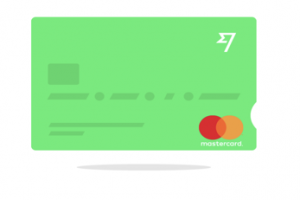
Read the full review
What are different types of travel cards?
Australians enjoy travelling overseas, especially to our neighbours in New Zealand. In fact, New Zealand remains our number one travel destination for Australian residents, with over 1.4 million of us visiting New Zealand last year.
When we travel to New Zealand we need access to cash. It's not the most glorious part of our travel plans, but it's equally important to decide on the best travel money option for us.
To help narrow your options, here is a list of the best Travel Cards and the key benefits and pitfalls of each one.
They can be either prepaid, debit or credit cards designed specially for overseas use. You can use travel cards to make purchases online, in stores and to withdraw money at ATMs. There are 3 popular types:
Prepaid Travel Cards
Travel debit cards, travel credit cards.
Let's have a look at each one.
Debit Cards offer the convenience of a credit card, but work differently. They draw money directly from your bank account when you make a purchase. It's designed for everyday money transactions and means that you're not accumulating debt.
A debit card could make you stick to your travel budget, because you can't overdraw money from your account. And for daily purchases, we think a debit card can help you stick to your travel budget, because you can't overdraw money from your account.
Generally, we recommend having the combination of a travel debit and travel credit card for safety, flexibility and convenience on your trip.
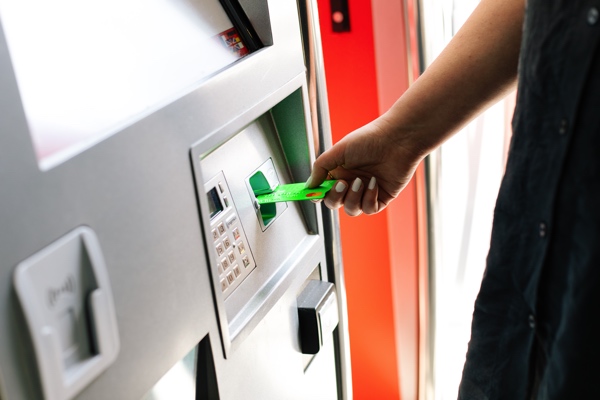
Wise - travel debit card for New Zealand
- No annual fee, hidden transaction fees, exchange rate markups
- No minimum balance requirements
- Allows you to make payments and withdrawals wherever you are in the world in over 40 currencies
- Local bank account details in Australia (AUD), the UK (GBP), the USA (USD), Europe (EUR) and New Zealand (NZD)
- It takes 7-14 business days to receive the card
- Can't always access local technical support depending on where you are
- Free cash withdrawals limited to under $350 every 30 days
- Only currently available in the US, UK, Europe, Australia and New Zealand
For prepaid cards, you're able to load the card with a set amount of money in the currencies you need. Ideally you do this before your trip, but often you can reload them as well.
Most prepaid travel cards allow for multiple currencies to be loaded onto the card. So it's important to know what currency you'll be using on your travels. Airlines also offer prepaid cards so the money you spend can earn you reward points.
With prepaid travel cards you need to be careful. They can have numerous fees and charges, which can make it more expensive than other options. But if you're organised and travelling to multiple cities a prepaid travel card is a good option.
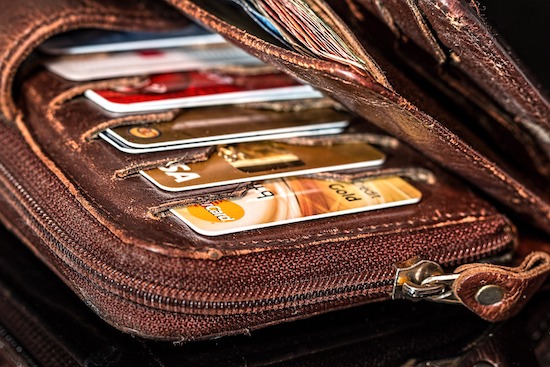
Revolut - prepaid travel card for New Zealand
- No purchase fee, load fee, reload fee, exchange rate margin or minimum balance requirements
- Unlike other Travel Cards, its free and easy to use the balance of your currency or convert it back to AUD
- Mid-market exchange rate, they add a mark-up for currency conversion during weekends
- For the free Standard account, there is a 2% ATM withdrawal fee when you withdraw over $350 during a month
- The premium account costs $10.99 a month, which can really add up if you are not using it often
Click here to see the full list of cards and how Revolut compares
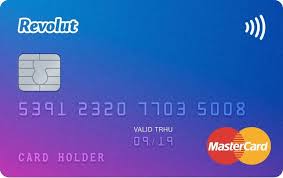
- Very easy to use app
- Free to set up
- No hidden fees or exchange rate mark-ups (except on weekends)
- You can use it to transfer money to a bank account overseas
- Additional fees for using the card on a weekend
- 2% ATM fee once you withdraw more than $350 in any 30 day period
- 3-4 business days before you receive your card
- Ongoing subscription fee for Premium and Metal cards
Credit cards have obviously been around for a long time. But now there are specialised travel credit cards. Generally, these cards give you longer to pay back what you've spent but the interest rates after this time can be quite high.
The main advantage with credit cards are the reward points you get in return for your customer loyalty when you spend. But it only works if you pay off the balance in full each month.
Credit cards are great to use for car hire, restaurants and accommodation - larger expenses that are easier for you to pay back over time. Some services only take credit cards to hold purchases so they can definitely be handy while you're travelling.
28 Degrees - travel credit card for New Zealand
- There are no annual fees
- No overseas purchase fee or currency conversion fee
- You get 55 days interest free on purchases
- Access to free 24/7 concierge service
- Emergency card replacement worldwide
The 28 Degrees Platinum Mastercard has additional benefits including shoppers and repayments benefits cover.
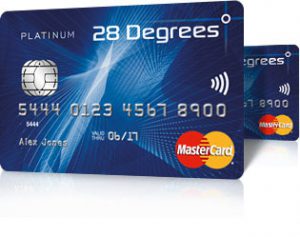
- Can have 9 additional cardholders
- No overseas purchase fee, or currency conversion fee
- No foreign transaction fee
- Free Replacement Card
- High interest rates after the initial 55 days
- Minimum credit limit is $6,000
- No introductory offers or rewards
Need to know more about travelling to New Zealand?
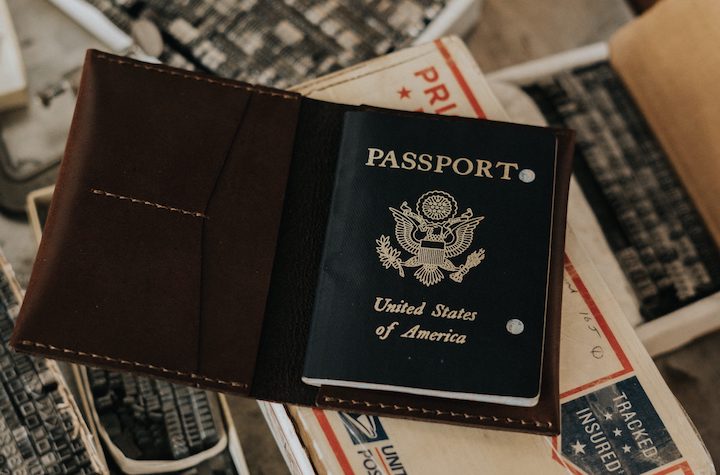
Passports, Visas and Vaccinations
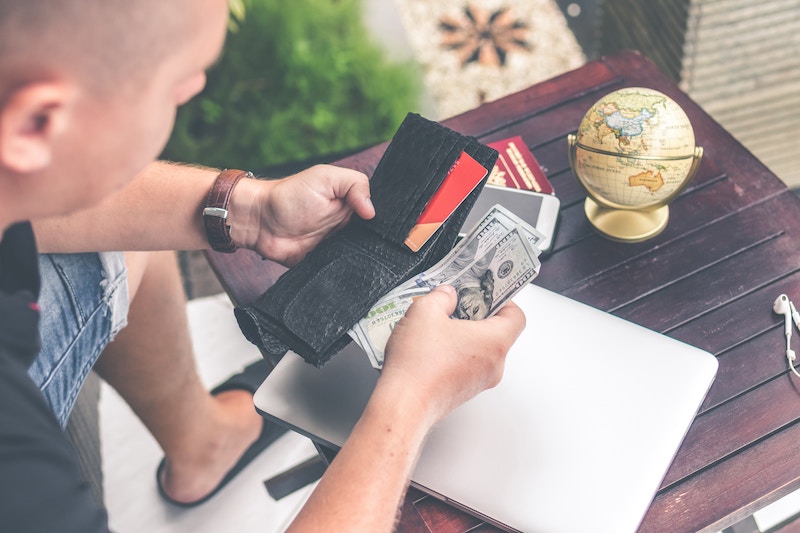
How Much Things Cost in New Zealand
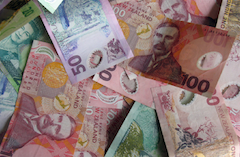
Currency in New Zealand
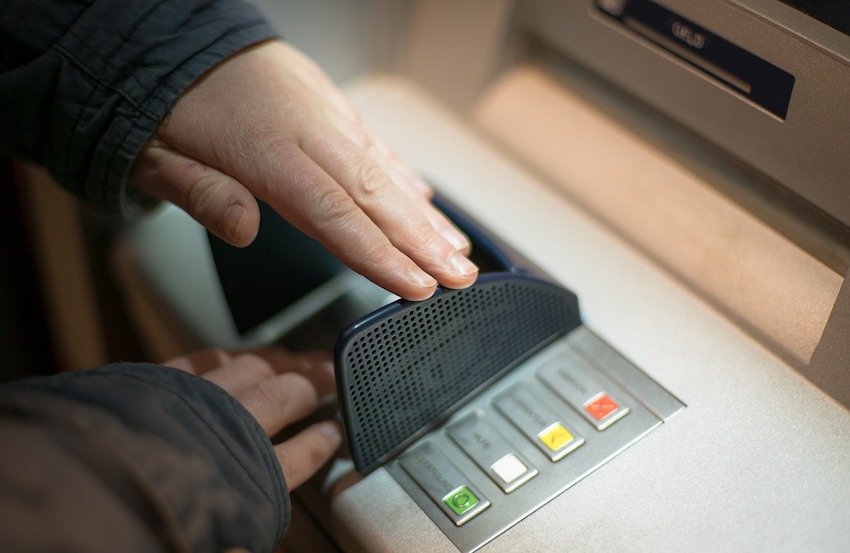
Banks, ATMs & Currency Exchange
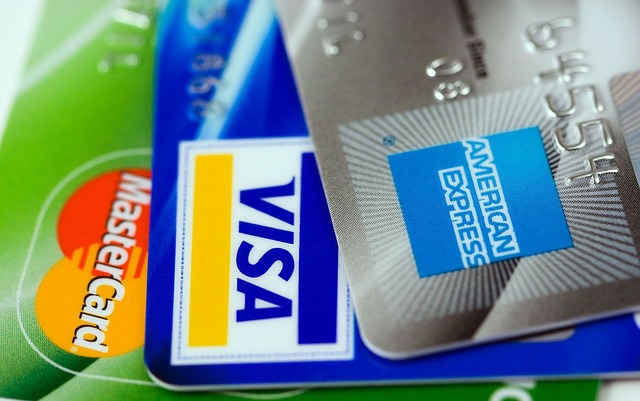
The Best Cards to Use in New Zealand
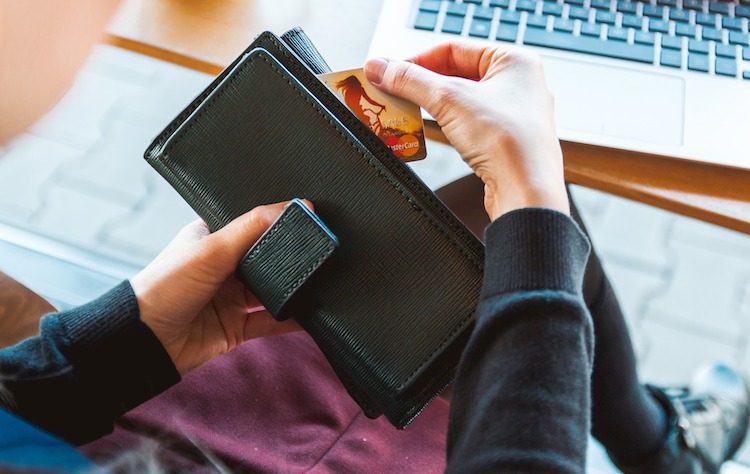
7 Common Travel Money Traps to Avoid in New Zealand
Activate your OneSmart™ card
And make spending overseas as easy as spending at home
Activate now
Don't have a card? Request one.
What is OneSmart ™ ?
If you’re an Airpoints™ member travelling the world, we can help make life a little easier when it comes to making purchases overseas.
OneSmart is a reloadable multi-currency prepaid card that can be used anywhere in the world that Mastercard is accepted.
OneSmart makes spending in different countries effortless – load up to eight foreign currencies, plus New Zealand Dollars.
The only prepaid card that earns you Airpoints Dollars™. You’ll earn 1 Airpoints Dollar for every $100NZD spent overseas. i
Learn more about the benefits of using OneSmart
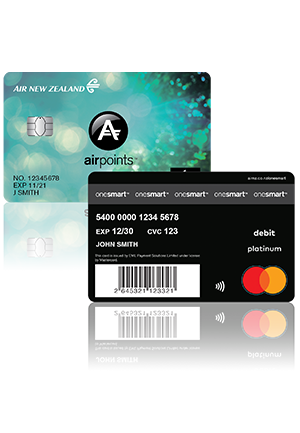
Activate OneSmart
When you receive your card, sign the back of your card, and activate it . You’ll only be able to use OneSmart after you’ve activated it.
To activate a new card, you’ll need two forms of identification. Have your driver’s license, birth certificate, NZ citizenship document, AA membership or a recent utility bill handy.
If you’re activating a replacement card, simply log in and follow the prompts or call our OneSmart Customer Service Centre for assistance on 0800 787 555 or +64 9 377 8535 if you’re overseas (charges may apply).
Activate OneSmart now
Set a PIN for OneSmart
If you are a new member activating OneSmart for the first time, select New Card and follow the instructions on screen. You will be prompted to set up a PIN during this activation.
If you have already activated OneSmart, here’s how you can reset your PIN:
- Login to OneSmart -Select 'Settings' (located at the top of the page, next to your Airpoints number) -Select 'Card settings’. -Select 'Set your PIN’. -Follow the screen prompts by answering the security questions and selecting a 4-digit PIN for your card.
If you have any questions, or run into issues setting your PIN, please call our OneSmart Customer Service Centre on 0800 787 555 or +64 9 377 8535 if you’re overseas (charges may apply).
Load money onto OneSmart
1. Via a Mastercard or Visa debit card issued in New Zealand. Instantly load NZD or any of our eight foreign currencies available with your debit card. A fee of 1.5% of the load value applies per transaction. Your funds will be available immediately.
2. Via Bank Transfer
Load directly into foreign currency or NZD without a fee.
Here are the steps: i. Log in to OneSmart ii. Select Settings, then 'Load settings' iii. Follow the instructions for Bank transfer Allow one business day for the funds to be available in OneSmart.
3. Via Bill Payment
Set up OneSmart as a bill payee through internet banking and use it to transfer NZD only to your OneSmart without a fee.
Here are the steps i. Login to OneSmart ii. Select Settings, then 'Load settings' iii. 3. Follow the instructions for ‘Bill Payment’ Allow up to 2 business days for the funds to show up in your OneSmart account.
Exchange Rates
- AUD Rate: 0.8784
- USD Rate: 0.5927
- GBP Rate: 0.4545
- SGD Rate: 0.7732
- EUR Rate: 0.5325
- HKD Rate: 4.6157
- JPY Rate: 86.1069
- CAD Rate: 0.8071
I have…
New Zealand Dollar
I need…
Fees & limits.
In addition to the currency exchange rates, the following fees and charges apply to OneSmart. The fees and charges may be altered by EML at its discretion by providing you with at least 20 days prior notice.
There are limits that apply to the use of your OneSmart facility. These limits are set out below but may be altered by EML from time to time pursuant to the Terms and Conditions.
Show fees & limits
Lost your OneSmart card?
You can temporarily suspend your card in the settings tab in ' My Account ' or lock your card via the OneSmart app
Alternatively, cancel your card by calling our OneSmart Customer Service Centre on 0800 787 555, or +64 9 377 8535 if you're overseas (charges may apply). We'll send you a replacement and you can use your new card to continue spending.
Download the OneSmart app
Use the app to load money and check the balances of each currency in your account, transfer funds between currencies, review your transaction history, view your Airpoints Dollar balance and more.

OneSmart Mastercard Priceless ® Specials
Discover exclusive Mastercard® curated offers and discounts with OneSmart. Available across a range of categories including entertainment, dining, arts and culture at home and overseas. Plus, you’ll earn Airpoints Dollars™ on eligible purchases 2 . Find out more
Frequently asked questions and contact help
Use OneSmart online or in-store, whether you are overseas or in New Zealand.
Load NZD or any of our eight foreign currencies and use OneSmart for purchases 1 wherever Mastercard® is accepted iii . Your card will utilise the funds available in the currency of transaction unless it is not an available currency or if there is insufficient balance in the relevant currency. In such cases, your card will draw on any available account balances in the following order of priority: NZD, AUD, USD, CAD, EUR, GBP, SGD, HKD, JPY. You can also use OneSmart to withdraw local currency from ATMs wherever you go as long as the ATM machines carry a Mastercard® symbol.
Note: It is currently not possible to use OneSmart due to restrictions in Iran, North Korea, Sudan, Syria and Russia, Crimea, Donetsk and Luhansk regions. Additionally, all Mastercards will not work at Russian merchants or ATMs. If you attempt to withdraw cash from an ATM or use your card in any of these countries, your request will be declined. In addition, card acceptance is subject to ATMs and individual merchant POS terminals who may choose not to accept Prepaid Cards.
Your OneSmart Account cannot be used for:
a) Purchases from merchants where the transaction is processed manually (through a zip-zap machine)
b) Direct debit, reoccurring or instalment payments
c) Purchases from merchants who do not accept prepaid Mastercard branded cards.
d) Gambling merchants
e) Adult entertainment
f) Transactions in countries prohibited by US Government sanctions and laws.
We recommend that you don't use OneSmart to "pre-authorise" payment for hotel bookings or car hire. This is because the hotel or car hire company can put the payment amount plus an additional 15% on hold as a deposit and you won't be able to use that money during the hold period. There is no issue in paying for your hotel using your OneSmart Account at the end of your stay, but we suggest you don't pre-authorise payment on it when booking.
We also recommend you don't use OneSmart for 'pay at the pump' terminals at petrol stations. These terminals place a hold on funds, and that hold may not be removed from your account for some days.
You can use your OneSmart for transactions anywhere Mastercard® is accepted electronically overseas. Simply load NZD and spend local currency wherever you are. You can also use OneSmart to withdraw local currency from ATMs as long as the ATM machines carry a Mastercard® symbol.
Note: Mastercard conversion rates and currency conversion fees will apply.
The limit for ATM withdrawals using OneSmart is NZD $3,000 or the equivalent in a foreign currency over any 24-hour period. Some ATMs may set their own withdrawal limits which may be lower than this.
No. When making a booking through the Air New Zealand website, payments made using OneSmart will not incur the advised card payment fee
For all new Silver tier members, OneSmart will automatically be sent to you. As you move up the tiers, you will be sent a new card if you have activated and used your OneSmart account previously. If you no longer receive OneSmart on your tier renewal, you can request a card at any time by calling the OneSmart Customer Service Centre on 0800 787 555 or +64 9 377 8535 if you're overseas (charges may apply).
Your OneSmart card details are on the back of your Airpoints membership card. Expiry is set at 4 months after your tier renewal date. This means that if you're overseas and haven't received your new card, you can still continue to use your existing card for purchases. Your OneSmart account will remain active, and you can log in using the website or app to manage your account.
The maximum balance allowed at any one time across all currencies is NZD $100,000 or currency equivalent.
Only one card is issued for each OneSmart account. Each family member who is a New Zealand based Airpoints member and who is over 16 can request to have their own OneSmart card. Card to card transfers between two activated OneSmart accounts can be done so you can transfer money to another OneSmart cardholder at no additional cost. Transfers can take up to two business days to process before funds are available for use.
You can view up to date OneSmart Conversion Rates here
If you are transferring funds between currencies, you can lock in your exchange rate at the time you make the transfer, so you know exactly how much it will cost and what will be loaded onto your card.
The side of your Airpoints card with the chip should be facing upwards and the chip goes into the ATM first.
Your card’s security code or CVC is the 3-digit number on the reverse side of your Airpoints card.
Some merchants may offer Dynamic currency conversion (“DCC”) that allows you to pay in your home currency or another currency when you are spending overseas or online. If you accept a Dynamic currency conversion transaction, you may end up incurring two currency conversions which could make the transaction significantly more expensive.
If you make a purchase or ATM withdrawal in a country where the local currency is the same as a currency on your OneSmart (e.g. using your US Dollar funds in the USA) and you opt in to a Dynamic currency conversion service, this may result in a foreign exchange transaction at additional cost to you as the card will seek to transact in New Zealand dollars.
We recommend that if you are given a choice of currency for a transaction and have sufficient funds, that you should choose to pay in the local currency.
Some merchants or ATM operators may charge a fee for dynamic currency conversion, which you might not be advised of at the time of the transaction.
For all eligible purchases with OneSmart 1 , we'll add the Airpoints Dollars you earn to your Airpoints account around the month anniversary of the date you activated your Account.
If you don't have enough funds in a particular currency to pay for a transaction, the balance of the transaction will be automatically processed from other currencies in the following order of priority. The order in which currencies are withdrawn cannot be changed.
NZD AUD USD CAD EUR GBP SGD HKD JPY In this case a currency conversion fee will apply each time a currency that is different to the transaction currency is used to fund all or part of the transaction. If after checking the available balances of all currencies there are still insufficient funds to pay for a transaction, the transaction may be declined, or the retailer may allow you to pay the balance by some other means.
If you had sufficient funds loaded in that currency, then you may have used Dynamic currency conversion.
When you’re paying with your OneSmart card, it will intelligently select the currency of the country you are in. If you do not have sufficient local currency loaded to complete the transaction, the card will deduct funds on the card in this set order of priority.
NZD AUD USD CAD EUR GBP SGD HKD JPY
You cannot spend money you haven’t loaded, as the card is a prepaid facility only. You can load straight into the available currencies of your choice in 'My Account' and lock in up to eight foreign currencies as well as NZD at the daily exchange rate ii .
An unsupported currency is any currency that is not included in the 9 supported currencies including NZD, which your OneSmart account can hold. The nine supported currencies are: New Zealand Dollars, Australian Dollars, Singapore Dollars, Hong Kong Dollars, Japanese Yen, Pounds sterling, Euros, Canadian Dollars, and United States Dollars.
The order in which currencies are withdrawn cannot be changed.
You can manage your OneSmart balances by signing into your account and selecting the Transfer money option from the main menu. To transfer money from your OneSmart account to your bank account follow the prompts for ‘Cash out’ to close your account and cash out any balance on your card free of charge.
You can also manage your OneSmart balances from the OneSmart app .
If you did not make a particular transaction showing on your transaction history, you should call OneSmart Customer Service Centre immediately on 0800 787 555 or +64 9 377 8535 if you’re overseas (charges may apply).
You can download a Dispute Claim Form here . Please allow up to 45 days for your dispute to be processed.
You will need the last 4 digits of your OneSmart card, and the email address associated with your OneSmart account; this may be different from the email address associated with your Airpoints account.
If you'd like to close your account, you can do so by calling the OneSmart Customer Service Centre on 0800 787 555 or +64 9 377 8535 if you're overseas (charges may apply).
Before you close your account, make sure you've transferred your money out of your account. You can also transfer any remaining balance back into NZD and into your bank account. This can be done online and via the OneSmart app.
The expiry date of your OneSmart card is printed on the OneSmart side of your Airpoints card. You cannot use your OneSmart Card to access money loaded onto your OneSmart facility after the expiry date. If you have an active OneSmart account and have made a transaction within the last five years a new card will be sent to you near your expiry date.
All Airpoints members who upgrade to Silver will receive a OneSmart by default. You can request a replacement OneSmart Card at any time. If your OneSmart Card expires, you will still be able to obtain your money loaded onto your OneSmart facility from EML through a cash out.
If you cease to be a member of the Airpoints Programme, you will not be able to continue using OneSmart and will need to cash out your OneSmart facility.
Still have a question?
Contact the OneSmart Customer Service Centre, we’re here to help 24/7.
Within NZ 0800 787 555
From Overseas +64 9 377 8535 (charges may apply)
OneSmart ™ Login
Forgotten your password.
Please enter your details below and we'll recover your password for you.
Password recovered
Password changed, change password.
To maintain security over your account you need to enter a new password to continue. To change your password, type your current password and your new password twice.
Are you activating a:
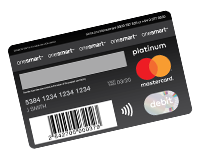
New to OneSmart and this is a first time activation.

Existing OneSmart member and this is a new card replacement activation.
Replacement card
- Credit cards
- View all credit cards
- Banking guide
- Loans guide
- Insurance guide
- Personal finance
- View all personal finance
- Small business
- Small business guide
- View all taxes
16 Best Travel Credit Cards of September 2024
The best travel credit card is one that brings your next trip a little closer every time you use it. Purchases earn points or miles you can use to pay for travel. If you're loyal to a specific airline or hotel chain, consider one of that company's branded travel credit cards. Otherwise, check out our picks for general-purpose travel cards that give you flexible travel rewards without the restrictions and blackout dates of branded cards.
400+ credit cards reviewed by our team of experts ( See our top picks )
80+ years of combined experience covering credit cards and personal finance
27,000+ hours spent researching and reviewing financial products in the last 12 months
Objective comprehensive ratings rubrics ( Methodology )
NerdWallet's credit cards content, including ratings and recommendations, is overseen by a team of writers and editors who specialize in credit cards. Their work has appeared in The Associated Press, USA Today, The New York Times, MarketWatch, MSN, NBC's "Today," ABC's "Good Morning America" and many other national, regional and local media outlets. Each writer and editor follows NerdWallet's strict guidelines for editorial integrity .
Show summary
NerdWallet's Best Travel Credit Cards of September 2024
Chase Sapphire Preferred® Card : Best for Max flexibility + big bonus
Capital One Venture Rewards Credit Card : Best for Flat-rate rewards
Capital One Venture X Rewards Credit Card : Best for Travel portal benefits
Chase Freedom Unlimited® : Best for Cash back for travel bookings
American Express® Gold Card : Best for Big rewards on everyday spending
Wells Fargo Autograph℠ Card : Best for Bonus rewards + no annual fee
The Platinum Card® from American Express : Best for Luxury travel perks
Ink Business Preferred® Credit Card : Best for Business travelers
Citi Strata Premier℠ Card : Best for Triple points on multiple categories
Capital One VentureOne Rewards Credit Card - Miles Boost : Best for Flat-rate rewards + no annual fee
Chase Sapphire Reserve® : Best for Bonus rewards + high-end perks
World of Hyatt Credit Card : Best for Best hotel card
Bilt World Elite Mastercard® Credit Card : Best for Travel rewards for rent payments
United℠ Explorer Card : Best for Best airline card
PenFed Pathfinder® Rewards Visa Signature® Card : Best for Credit union benefits
Wells Fargo Autograph Journey℠ Card : Best for Booking directly with airlines/hotels
Best Travel Credit Cards
Find the right credit card for you..
Whether you want to pay less interest or earn more rewards, the right card's out there. Just answer a few questions and we'll narrow the search for you.
Max flexibility + big bonus
Flat-rate rewards, travel portal benefits, cash back for travel bookings, big rewards on everyday spending, bonus rewards + no annual fee, luxury travel perks, business travelers, triple points on multiple categories, flat-rate rewards + no annual fee, bonus rewards + high-end perks, best hotel card, travel rewards for rent payments, best airline card, credit union benefits, booking directly with airlines/hotels, full list of editorial picks: best travel credit cards.
Before applying, confirm details on the issuer’s website.
Capital One Venture Rewards Credit Card
Our pick for: Flat-rate rewards
The Capital One Venture Rewards Credit Card is probably the best-known general-purpose travel credit card, thanks to its ubiquitous advertising. You earn 5 miles per dollar on hotels and car rentals booked through Capital One Travel and 2 miles per dollar on all other purchases. Miles can be redeemed at a value of 1 cent apiece for any travel purchase, without the blackout dates and other restrictions of branded hotel and airline cards. The card offers a great sign-up bonus and other worthwhile perks ( see rates and fees ). Read our review.
Capital One VentureOne Rewards Credit Card - Miles Boost
Our pick for: Flat-rate rewards + no annual fee
With the Capital One VentureOne Rewards Credit Card - Miles Boost , you don't pay an annual fee, but you also don't get rewards as rich as those on the regular Venture card ( see rates and fees ). Still, the bonus offer makes this a solid card for starting out with travel rewards. Read our review.
Chase Sapphire Reserve®
Our pick for: Bonus rewards + high-end perks
The high annual fee on the Chase Sapphire Reserve® gives many potential applicants pause, but frequent travelers should be able to wring enough value out of this card to more than make up for the cost. Cardholders get bonus rewards (up to 10X) on dining and travel, a fat bonus offer, annual travel credits, airport lounge access, and a 50% boost in point value when redeeming points for travel booked through Chase. Points can also be transferred to about a dozen airline and hotel partners. Read our review.
Chase Sapphire Preferred® Card
Our pick for: Max flexibility + big bonus
For a reasonable annual fee, the Chase Sapphire Preferred® Card earns bonus rewards (up to 5X) on travel, dining, select streaming services, and select online grocery purchases. Points are worth 25% more when you redeem them for travel booked through Chase, or you can transfer them to about a dozen airline and hotel partners. The sign-up bonus is stellar, too. Read our review.
Wells Fargo Autograph Journey℠ Card
Our pick for: Booking directly with airlines/hotels
The Wells Fargo Autograph Journey℠ Card stands out among general-purpose travel cards because it pays its highest rewards rates on travel bookings made directly with airlines and hotels, rather than requiring you to go through the issuer's travel agency, where prices might not be competitive. The points are flexible, you get a good bonus offer, and the card comes with a few other nice perks. Read our review.
Wells Fargo Autograph℠ Card
Our pick for: Bonus rewards + no annual fee
The Wells Fargo Autograph℠ Card offers so much value, it's hard to believe there's no annual fee. Start with a great bonus offer, then earn extra rewards in a host of common spending categories — restaurants, gas stations, transit, travel, streaming and more. Read our review.
Citi Strata Premier℠ Card
Our pick for: Triple points on everyday categories
The Citi Strata Premier℠ Card earns bonus points on select travel, supermarkets, dining, gas stations and EV stations. There's a solid sign-up bonus as well. Read our review.
U.S. Bank Altitude® Connect Visa Signature® Card
Our pick for: Road trips
The U.S. Bank Altitude® Connect Visa Signature® Card is one of the most generous cards on the market if you're taking to the skies or the road, thanks to the quadruple points it earns on travel and purchases at gas stations and EV charging stations. It's also a solid card for everyday expenses like groceries, dining and streaming, and it comes with ongoing credits that can offset its annual fee: $0 intro for the first year, then $95 . Read our review .
Capital One Venture X Rewards Credit Card
Our pick for: Travel portal benefits
Capital One's premium travel credit card can deliver terrific benefits — provided you're willing to do your travel spending through the issuer's online booking portal. That's where you'll earn the highest rewards rates plus credits that can make back the bulk of your annual fee ( see rates and fees ). Read our review.
Chase Freedom Unlimited®
Our pick for: Cash back for travel bookings
The Chase Freedom Unlimited® was already a fine card when it offered 1.5% cash back on all purchases. Now it's even better, with bonus rewards on travel booked through Chase, as well as at restaurants and drugstores. On top of all that, new cardholders get a 0% introductory APR period and the opportunity to earn a sweet bonus. Read our review.
The Platinum Card® from American Express
Our pick for: Luxury travel perks
The Platinum Card® from American Express comes with a hefty annual fee, but travelers who like to go in style (and aren't afraid to pay for comfort) can more than get their money's worth. Enjoy extensive airport lounge access, hundreds of dollars a year in travel and shopping credits, hotel benefits and more. That's not even getting into the high rewards rate on eligible travel purchases and the rich welcome offer for new cardholders. Read our review.
American Express® Gold Card
Our pick for: Big rewards on everyday spending
The American Express® Gold Card can earn you a pile of points from everyday spending, with generous rewards at U.S. supermarkets, at restaurants and on certain flights booked through amextravel.com. Other benefits include hundreds of dollars a year in available dining and travel credits and a solid welcome offer for new cardholders. There's an annual fee, though, and a pretty substantial one, so it's not for smaller spenders. Read our review.
Bilt World Elite Mastercard® Credit Card
Our pick for: Travel rewards on rent payments
The Bilt World Elite Mastercard® Credit Card stands out by offering credit card rewards on rent payments without incurring an additional transaction fee. The ability to earn rewards on what for many people is their single biggest monthly expense makes this card worth a look for any renter. You also get bonus points on dining and travel when you make at least five transactions on the card each statement period, and redemption options include point transfers to partner hotel and loyalty programs. Read our review.
PenFed Pathfinder® Rewards Visa Signature® Card
Our pick for: Credit union rewards
With premium perks for a $95 annual fee (which can be waived in some cases), jet-setters will get a lot of value from the PenFed Pathfinder® Rewards Visa Signature® Card . It also offers a generous rewards rate on travel purchases and a decent flat rate on everything else. Plus, you’ll get travel credits and a Priority Pass membership that offers airport lounge access for $32 per visit. Read our review.
United℠ Explorer Card
Our pick for: B est airline card
The United℠ Explorer Card earns bonus rewards not only on spending with United Airlines but also at restaurants and on eligible hotel stays. And the perks are outstanding for a basic airline card — a free checked bag, priority boarding, lounge passes and more. Read our review.
» Not a United frequent flyer? See our best airline cards for other options
World of Hyatt Credit Card
Our pick for: Best hotel card
Hyatt isn't as big as its competitors, but World of Hyatt Credit Card is worth a look for anyone who spends a lot of time on the road. You can earn a lot of points even on non-Hyatt spending, and those points have a high value compared with rival programs. There's a great sign-up bonus, free nights, automatic elite status and more. Read our review.
» Not a Hyatt customer? See our best hotel cards for other options.
Ink Business Preferred® Credit Card
Our pick for: Business travelers
The Ink Business Preferred® Credit Card starts you off with one of the biggest sign-up bonuses of any credit card anywhere: Earn 120k bonus points after you spend $8,000 on purchases in the first 3 months from account opening. That's $1,200 cash back or $1,500 toward travel when redeemed through Chase Travel℠. You also get bonus rewards on travel expenses and common business spending categories, like advertising, shipping and internet, cable and phone service. Points are worth 25% more when redeemed for travel booked through Chase, or you can transfer them to about a dozen airline and hotel partners. Learn more and apply .
OTHER RESOURCES
How travel rewards work.
Modern-day adventurers and once-a-year vacationers alike love the idea of earning rewards toward their next big trip. According to a NerdWallet study , 68% of American adults say they have a credit card that earns travel rewards.
With a travel rewards credit card, you earn points or miles every time you use the card, but you can often earn more points per dollar in select categories. Some top travel credit cards, such as the Chase Sapphire Reserve® , offer bonus points on any travel spending, while the Marriott Bonvoy Boundless® Credit Card grants bonus points when you use the card at Marriott hotels, grocery stores, restaurants or gas stations.

Not all points and miles earned on travel rewards credit cards are the same:
General-purpose travel credit cards — including the Chase Sapphire Preferred® Card , the American Express® Gold Card and the Capital One Venture Rewards Credit Card — give you rewards that can be used like cash to pay for travel or that can be exchanged for points in airline or hotel loyalty programs. With their flexible rewards, general-purpose options are usually the best travel credit cards for those who don't stick to a single airline or hotel chain.
Airline- and hotel-specific cards — such as the United℠ Explorer Card and the Hilton Honors American Express Card — give points and miles that can be used only with the brand on the card. (Although it's possible in some cases to transfer hotel points to airlines, we recommend against it because you get a poor value.) These so-called co-branded cards are usually the best travel credit cards for those who always fly one particular airline or stay with one hotel group.
How do we value points and miles? With the rewards earned on general travel cards, it's simple: They have a fixed value, usually between 1 and 1.5 cents per point, and you can spend them like cash. With airline miles and hotel points, finding the true value is more difficult. How much value you get depends on how you redeem them.
To better understand what miles are worth, NerdWallet researched the cash prices and reward-redemption values for hundreds of flights. Our results:
Keep in mind that the airline values are based on main cabin economy tickets and exclude premium cabin redemptions. See our valuations page for business class valuations and details about our methodology.
Our valuations are different from many others you may find. That’s because we looked at the average value of a point based on reasonable price searches that anyone can perform, not a maximized value that only travel rewards experts can expect to reach.
You should therefore use these values as a baseline for your own redemptions. If you can redeem your points for the values listed on our valuations page, you are doing well. Of course, if you are able to get higher value out of your miles, that’s even better.
HOW TO CHOOSE A TRAVEL CREDIT CARD
There are scores of travel rewards cards to choose from. The best travel credit card for you has as much to do with you as with the card. How often you travel, how much flexibility you want, how much you value airline or hotel perks — these are all things to take into account when deciding on a travel card. Our article on how to choose a travel credit card recommends that you prioritize:
Rewards you will actually use (points and miles are only as good as your ability to redeem them for travel).
A high earning rate (how much value you get in rewards for every dollar spent on the card).
A sign-up bonus (a windfall of points for meeting a spending requirement in your first few months).
Even with these goals in mind, there are all kinds of considerations that will influence your decision on a travel rewards credit card.

Travel cards are for travelers
Travel cards vs. cash-back cards.
The very first question to ask yourself when choosing a travel credit card is: Should I get a travel card at all? Travel credit cards are best for frequent travelers, who are more likely to get enough value from rewards and perks to make up for the annual fees that the best travel credit cards charge. (Some travel cards charge no annual fee, but they tend to offer lesser rewards than full-fee cards.) A NerdWallet study found that those who travel only occasionally — say, once a year — will probably get greater overall rewards from cash-back credit cards , most of which charge no annual fee, than from a travel card.
Flexibility and perks: A trade-off
Co-branded cards vs. general travel cards.
Travel credit cards fall into two basic categories: co-branded cards and general travel cards.
Co-branded cards carry the name of an airline or hotel group, such as the United℠ Explorer Card or the Marriott Bonvoy Boundless® Credit Card . The rewards you earn are redeemable only with that particular brand, which can limit your flexibility, sometimes sharply. For example, if your credit card's co-branded airline partner doesn't have any award seats available on the flight you want on the day you want, you're out of luck. On the other hand, co-branded cards commonly offer airline- or hotel-specific perks that general travel cards can't match.
General travel cards aren't tied to a specific airline or hotel, so they offer much greater flexibility. Well-known general travel cards include the Capital One Venture Rewards Credit Card and the Chase Sapphire Preferred® Card . Rewards on general travel cards come as points (sometimes called "miles" but they're really points) that you can redeem for any travel expense. You're not locked into using a single airline or hotel, but you also won't enjoy the perks of a co-branded card.
Evaluating general travel credit cards
What you get with a general travel card.
The credit cards featured at the top of this page are general travel cards. They're issued by a bank (such as Chase or Capital One), carry only that bank's name, and aren't tied to any single airline or hotel group. With these cards, you earn points on every purchase — usually 1 to 2 points per dollar spent, sometimes with additional points in certain categories.
Issuers of general travel cards typically entice new applicants with big sign-up bonuses (also known as "welcome offers") — tens of thousands of miles that you can earn by spending a certain amount of money on the card in your first few months.
» MORE: NerdWallet's best credit card sign-up offers
What do you do with those points? Depending on the card, you may have several ways to redeem them:
Booking travel. With this option, your points pay for travel booked through the issuer's website, using a utility similar to Orbitz or Expedia. For example, if points were worth 1 cent apiece when redeemed this way, you could book a $400 flight on the issuer's portal and pay for it with 40,000 points
Statement credit. This lets you essentially erase travel purchases by using your points for credit on your statement. You make travel arrangements however you want (directly with an airline or hotel, through a travel agency, etc.) and charge it to your card. Once the charge shows up on your account, you apply the necessary points and eliminate the cost.
Transferring to partners. The card issuer may allow you to transfer your points to loyalty programs for airlines or hotel chains, turning your general card into something like a co-branded card (although you don't get the perks of a co-brand).
Cash back, gift cards or merchandise. If you don't plan to travel, you can burn off your rewards with these options, although you'll often get a lower value per point.
Airline and hotel cards sharply limit your choice, but they make up for it with perks that only they can offer, like free checked bags or room upgrades. General travel cards, on the other hand, offer maximum flexibility but can't provide the same kinds of perks, because the banks that issue them don't operate the airlines or hotels. Still, there are some noteworthy perks on general travel cards, including:
Travel credit. This is automatic reimbursement for travel-related spending. Some top travel credit cards offer hundreds of dollars a year in travel credit.
Trusted traveler reimbursement. More and more travel credit cards are covering the application fee for TSA Precheck and Global Entry, programs that allow you to move through airport security and customs more quickly.
Airport lounge access. Hundreds of lounges worldwide operate separately from airlines under such networks as Priority Pass and Airspace, and several general travel cards offer access to these lounges.
Points programs
Every major card issuer has at least one travel card with a points program. American Express calls its program Membership Rewards, while Chase has Ultimate Rewards® and Citi pays in ThankYou points. Wells Fargo has Wells Fargo Rewards, and U.S. Bank has FlexPerks. Bank of America® travel cards offer points without a fancy name. Travel cards from Capital One, Barclays and Discover all call their points "miles."
These programs differ in how much their points are worth and how you can use them. Some offer the full range of redemption options, including transfers to loyalty programs. Others let you use them only to book travel or get statement credit.
» MORE: Travel loyalty program reviews
Evaluating airline credit cards
What you get with an airline credit card.
Airline credit cards earn "miles" with each purchase. You typically get 1 mile per dollar spent, with a higher rate (2 or more miles per dollar) on purchases with the airline itself. (Some airline cards have also begun offering extra miles for purchases in additional categories, such as restaurants or car rental agencies.) These miles go into the same frequent-flyer account as the ones you earn by flying the airline, and you can redeem them for free flights with the airline or its alliance partners.
Co-branded airline cards typically offer sign-up bonuses (or welcome offers). But what really sets them apart are the perks they give you. With some cards, for example, the checked-bag benefit alone can make up for the annual fee after a single roundtrip by a couple. Common perks of airline cards include:
Free checked bags. This commonly applies to the first checked bag for you and at least one companion on your reservation. Some cards extend this perk to more people, and higher-end cards (with higher annual fees) may even let you check two bags apiece for free.
Priority boarding. Holders of co-branded airline credit cards often get to board the plane early — after the airline's elite-status frequent flyers but before the general population. This gives you time to settle in and gives you a leg up on claiming that coveted overhead bin space.
In-flight discounts or freebies. You might get, say, 25% off the cost of food and beverages during the flight, or free Wi-Fi.
Airport lounge access. High-end cards often include a membership to the airline's airport lounges, where you can get away from the frenzy in the terminal and enjoy a complimentary snack. Some less-expensive airline cards give you only limited or discounted lounge access; others give you none at all.
Companion fares. This perk lets you bring someone with you for a lower cost when you buy a ticket at full price.
A boost toward elite status. Miles earned with a credit card, as opposed to those earned from actually flying on the airline, usually do not count toward earning elite status in an airline's frequent-flyer program. However, carrying an airline's high-end card might automatically qualify you for a higher tier within the program.
The biggest U.S. airlines — American, United and Delta — offer an array of credit cards. Each airline has a no-annual-fee card that earns miles on purchases but provides little in the way of perks (no free bags or priority boarding). Each has a high-end card with an annual fee in the neighborhood of $450 that offers lounge access and sumptuous perks. And each has a "middle-class" card with a fee of around $100 and solid ongoing perks. Southwest offers three credit cards with varying fees; smaller carriers may just have a single card.
» MORE: NerdWallet's best airline credit cards
Choosing an airline
Which airline card you get depends in large part on what airline you fly, and that's heavily influenced by where you live. Alaska Airlines, for example, has an outstanding credit card, but the airline's routes are concentrated primarily on the West Coast. So it's not a great option for those who live in, say, Buffalo, New York, or Montgomery, Alabama.
If your local airport is dominated by a single airline, then you're probably flying that carrier most (or all) of the time by default. Delta, for example, is the 800-pound gorilla at Minneapolis-St. Paul and Salt Lake City. United has the bulk of the traffic at Newark and Washington Dulles. American calls the shots at Charlotte and Dallas-Fort Worth. That airline's credit card may be your only realistic option. If you're in a large or midsize market with frequent service from multiple airlines, you have more choice.
» MORE: How to choose an airline credit card
Evaluating hotel credit cards
What you get with a hotel card.
Hotel credit cards earn points with each purchase. As with airline cards, you typically get more points per dollar for purchases from the co-brand partner, and some cards also give bonus points in additional categories. (Hotel cards tend to give you a greater number of points overall than airline cards, but each individual point is generally worth less than a typical airline mile.) Similar to the airline model, the points you earn with the card go into the same loyalty account as the points you earn from actually staying at a hotel. You redeem your points for free stays.
Hotel cards usually offer a sign-up bonus, but like airline cards, they really make their bones with the ongoing perks. Common perks on hotel cards include:
Free nights. Several cards offer this perk, which can make up for the card's annual fee. You may get a free night automatically every year, or you may unlock it by spending a certain amount within a year. In the latter case, it comes on top of the points you earn for your spending.
Upgrades and freebies. Cardholders may qualify for automatic room upgrades when available, or free or discounted amenities such as meals or spa packages.
Early check-in/late check-out. No one likes having to cool their heels in the hotel lobby waiting for 3 o'clock to check in. And no one likes have to vacate their room by 11 a.m. when their flight doesn't leave till evening.
Accelerated elite status. Some hotel cards automatically bump you up a level in their loyalty program just for being a cardholder.
» MORE: NerdWallet's best hotel credit cards
Choosing a hotel group
If you decide to go the hotel-card route, you'll need to decide which hotel group gets your business. Hotels aren't as market-concentrated as airlines, so if your travels take you mostly to metropolitan areas, you'll have a decent amount of choice. Keep in mind that even though there are dozens of nationally recognizable hotel brands, ranging from budget inns to luxury resorts, many of them are just units in a larger hotel company, and that company's card can unlock benefits across the group.
Marriott, for example, includes not only its namesake properties but nearly 30 other brands, including Courtyard, Fairfield, Renaissance, Residence Inn, Ritz-Carlton, Sheraton and Westin. The Hilton family includes DoubleTree, Embassy Suites, Hampton Inn and Waldorf-Astoria. InterContinental includes Holiday Inn, Candlewood, Staybridge and Crowne Plaza. Wyndham and Choice have more than 15 mid-tier and budget-oriented brands between them.
HOW TO COMPARE TRAVEL CREDIT CARDS
No travel rewards credit card is going to have everything you want. You're going to be disappointed if you expect to find a high rewards rate, a generous sign-up bonus, top-notch perks and no annual fee. Each card delivers value through a different combination of features; it's up to you to compare cards based on the following features and choose the best travel credit card for your needs and preferences.
Most of the best travel cards charge an annual fee. Fees in the range of $90 to $100 are standard for travel cards. Premium cards with extensive perks will have fees of $450 or more. Weigh the value of the rewards and perks you'll get to make sure they'll make up for the fee.
Can you find good cards without an annual fee? Absolutely! There are no-fee options on our list of the best travel credit cards, and we've rounded up more here . Just be aware that if you go with a no-fee travel card, you'll earn rewards at a lower rate, your sign-up bonus will be smaller, and you won't get as many (if any) perks.
Rewards rate
Rewards can be thought of in terms of "earn rate" and "burn rate".
The earn rate is how many points or miles you receive per dollar spent. Some general travel cards offer flat-rate rewards, meaning you get the same rate on all purchases, all the time — 2 miles per dollar, for example, or 1.5 points per dollar. Others, including most co-branded cards, offer a base rate of maybe 1 point per dollar and then pay a higher rate in certain categories, such as airline tickets, hotel stays, general travel expenses or restaurant meals.
The burn rate is the value you get for those points or miles when you redeem them. The industry average is about 1 cent per point or mile. Some cards, particularly hotel cards, have lower value per point on the "burn" side but give you more points per dollar on the earning side.
When comparing rewards rates, don't just look at the numbers. Look at the categories to which those numbers apply, and find a card that matches your spending patterns. Getting 5 points per dollar seems great — but if those 5X points come only on purchases at, say, office supply stores, and you don't spend money on office supplies, then you're getting lousy value.
Sign-up bonus
Travel cards tend to have the biggest sign-up bonuses — tens of thousands of points that you earn by hitting a certain amount of spending. But there's more to consider when comparing sign-up bonuses than just how many points or miles you earn. You must also take into account how much you have to spend to earn the bonus. While cash-back credit cards often require just $500 to $1,000 in spending over three months to unlock a bonus, travel cards commonly have thresholds of $3,000 to $5,000.
Never spend money you don't have just to earn a sign-up bonus. Carrying $3,000 in debt for a year in order to earn a $500 bonus doesn't make economic sense — the interest you'll pay could easily wipe out the value of the bonus.
Finally, keep in mind that the biggest bonuses will come on cards with annual fees.
Foreign transaction fees
A good travel card will not charge a foreign transaction fee. These fees are surcharges on purchases made outside the U.S. The industry standard is about 3%, which is enough to wipe out most if not all of the rewards you earn on a purchase. If you never leave the U.S., then this isn't much of a concern, but anyone who travels abroad should bring a no-foreign-transaction-fee card with them.
Some issuers don't charge foreign transaction fees on any of their cards. Others charge them on some cards but not all.
International acceptance
Not all travel credit cards are great companions for international travel. While Visa and Mastercard are good pretty much worldwide, you may encounter limited acceptance for American Express and, especially, Discover, depending on the destination. This doesn't mean world travelers should dismiss AmEx and Discover. Just know that if you take one of these cards with you overseas, you'd be smart to bring along a backup in case you run into acceptance problems. (Having a backup card is good advice within the U.S., too, really.)
Travel protections
Consider which travel protections — car rental insurance , trip cancellation coverage , lost baggage protection — are important to you.
"Rewards" are what you get for using a credit card — the points earned with each transaction and the bonuses you unlock with your spending. "Perks" are goodies that you get just for carrying the card. There's a very close correlation between the annual fee on a card and the perks you get for carrying it. Cards with no annual fee are all about rewards and go very light on perks. Premium cards with annual fees of $450 or more are laden with perks (although sometimes their rewards aren't too special). Midtier cards (in the $100 range) tend to have solid rewards and a handful of high-value perks.
Assuming you take advantage of them, the perks often make up for the annual fee on a card quite easily. This is especially true with co-branded cards. Free checked bags can pay for an airline card several times over, and a free night is usually worth more than the fee on a hotel card. When comparing the perks of various cards, be realistic about which ones you will and won't use. Sure, that card may entitle you to a free spa package the next time you're at a five-star hotel, but how often do you stay at five-star hotels?
SHOULD YOU GET A TRAVEL CARD? PROS AND CONS
Pros: why it's worth getting a travel card.
The sign-up bonus gives you a big head-start on travel. Bonuses on the best travel credit cards typically run $500 or more — enough for a roundtrip ticket in many instances.
Perks make travel less expensive and more relaxing. You won't have to worry about cramming a week's worth of clothes into a carry-on if your travel credit card gives you a free checked bag (or automatically reimburses you for the bag fee). Hate the crush of travelers in the terminal? Escape to the airport lounge. Renting a car? Use a travel card that provides primary rental car insurance.
Rewards get you closer to your next trip with every purchase. Spending money on the mundane activities of daily life has a silver lining when you know that every $1,000 you spend will knock $10 or $20 off the cost of that future beach vacation or trip home to see Mom and Dad.
No foreign transaction fee can mean big savings. Take just any old credit card with you on vacation outside the U.S., and $1,000 worth of purchases can cost you $30 off the top due to the foreign transaction surcharge. Good travel cards don't charge this fee.
"Double dipping" gives you more points on travel purchases. Buy a plane ticket or book a hotel room, and you'll earn loyalty points or miles regardless of how you pay. Use the right credit card, though, and you'll earn even more points and miles on top of those.
Strategic redemption can multiply your value. With cash-back credit cards, 1 cent is worth 1 cent, and that's just how it goes. The points and miles on many travel credit cards have variable value based on how you redeem them — booking travel with them vs. transferring them to a partner, booking domestic vs. international flights and economy vs. business class, staying at budget hotels vs. high-end resorts, and so on.
Cons: Why a travel card might not be for you
The best cards charge annual fees. In many cases, the value you get from a credit card more than makes up for the annual fee. But some people are dead set against paying a fee under any circumstances. If that's you, your options in travel cards will be sharply limited, and you won't get the perks that provide a big portion of the value on many cards.
Sign-up bonus spending requirements can be steep. A bonus worth $500, $600 or $700 is attractive, but only if you can afford to earn it with spending you were going to do anyway. If you have to amass thousands of dollars in debt and then pay interest on it, it's not worth it.
Travel cards aren't ideal for infrequent travelers. In the first year with a travel card, you're probably going to come out ahead: You can earn a big sign-up bonus, and several popular cards waive the first year's annual fee, too. In subsequent years, though, you'll break even on that fee only if you use the card enough to make up for it (with the rewards you earn and redeem and the perks you use). Infrequent travelers are more likely to get more total rewards from a cash-back card with no annual fee.
Cash back is simpler and more flexible. Some travel cards allow you to redeem your rewards only for travel. Others give you poor value unless you redeem for travel. Still others have complicated redemption options, making it hard to get the most out of your rewards. With cash-back credit cards, you can use your rewards on anything, you know exactly how much your rewards are worth, and redemption is usually simple.
Rewards cards tend to charge higher interest rates. If you regularly carry a balance from month to month, a travel credit card — or any rewards credit card — probably isn't your best choice. The interest you pay is eating up the value of your rewards. You're better off with a low-interest card that reduces the cost of carrying debt.
MAKING THE MOST OF YOUR TRAVEL CARD
Maximize your rewards with the following tips:
Plan your credit card application around a big purchase to earn the sign-up bonus.
Seize every opportunity to pick up the tab, especially if your travel credit card pays bonus rewards on dining; your friends can pay you back while you collect rewards.
Redeem rewards for travel instead of gift cards, merchandise or (in most cases) cash back to get the best value.
Join the loyalty program associated with a co-branded card — a frequent-flyer or frequent-guest program.
Shop for essentials in your card’s online bonus mall or through its exclusive offers, if available, to get extra rewards.
OTHER CARDS TO CONSIDER
It’s worth considering whether a travel credit card is even right for you in the first place. A NerdWallet study found that cash-back credit cards often earn more money — even for many travelers.
If you carry a balance from month to month, the higher interest rates typically charged by rewards cards can cancel out any rewards earned. If you have a good credit score, you're better off with a low-interest credit card that can save you money on interest.
A good travel credit card shouldn't charge foreign transaction fees, but there are good non-travel cards that also don't charge them. See our best cards with no foreign transaction fee .
If you value transparency and flexibility in your rewards, you can't go wrong with a cash-back card — and you can still use the rewards for travel, if you want.
Finally, if you're still not sure what's right for you, take a look at our best rewards credit cards for options beyond travel and cash back.
NerdWallet's Sam Kemmis contributed to this article.
To view rates and fees of the American Express® Gold Card , see this page . To view rates and fees of The Platinum Card® from American Express , see this page .
Last updated on August 20 , 2024
Methodology
NerdWallet's Credit Cards team selects the best travel rewards credit cards based on overall consumer value, as evidenced by star ratings, as well as their suitability for specific kinds of travelers. Factors in our evaluation include each card's annual fee, foreign transaction fees, rewards earnings rates, ease of use, redemption options, domestic and international acceptance, promotional APR period, bonus offers, and cardholder perks such as automatic statement credits and airport lounge access. Learn how NerdWallet rates credit cards.
Frequently asked questions
Travel credit cards earn points (sometimes called miles) each time you buy something. The standard earning rate is 1 to 2 points per dollar spent, and many cards give you extra points for certain purchases, particularly travel expenses. The value of a point depends on the card that earned it and how you redeem it, but a good rule of thumb is to assume each point is worth an average of about 1 cent.
Your points accumulate in a rewards account, where you can use them to pay for travel. Most cards let you book travel directly using a portal similar to those at online travel agencies or on airline and hotel websites, but instead of paying cash, you pay with your points. Depending on the card, you may also have the option of booking travel any way you want, paying for it with the card and then cashing in your points for a credit against those expenses.
Points and miles are just different names for the same thing: the currency used in a travel rewards program. Some travel credit cards call them points, some call them miles.
Airline frequent flyer programs have long used the term “miles” to refer to the rewards you earn for flying. That’s because at one time, you really did earn rewards according to how many miles you flew — the longer the flight, the more miles you earned. Nowadays, most domestic airlines give out “miles” based on how much you spend, not how far you fly, so they’re really just points. (There are a few exceptions, though, notably Alaska Airlines.)
Especially when it comes to redeeming your rewards, there’s no difference between points and miles. The number of points or miles you need is based mostly on the cost of what you’re redeeming them for. It takes more than 500 miles (value about: $5) to get a free 500-mile flight!
The value of a point or mile depends on the card you earned it with and how you redeem it. A common rule of thumb is to assume that each point or mile is worth an average of 1 cent, although you can certainly get a much higher (or lower) redemption value. See our travel loyalty roundup page for NerdWallet’s current valuations for airline miles and hotel points.
Travel credit cards fall into two main categories: co-branded and general-purpose.
• Co-branded travel cards carry the name of an airline or hotel chain. The rewards you earn on the card can typically be redeemed only with that brand (or maybe its partners). Co-branded cards limit your flexibility, but because they are issued in partnership with an airline or hotel, they can give you special perks, like free checked bags or room upgrades.
• General-purpose travel cards are issued by a credit card company and are not directly tied to any particular airline or hotel. They earn points in the issuer's own program, such as American Express Membership Rewards, Chase Ultimate Rewards® or Citi ThankYou. These points are a lot more flexible, as you can use them to pay for a range of travel expenses, including flights on any airline or stays at any hotel. However, they don’t offer the airline- or hotel-specific perks of co-branded cards.
Travel cards — like rewards cards in general — typically require good to excellent credit for approval. Good credit is generally defined as a credit score of 690 or better. However, credit scores alone do not guarantee approval. Every issuer has its own criteria for evaluating applications.
Business travel can earn credit card rewards just like leisure travel. Credit cards that earn rewards for travel purchases don't distinguish between one or the other — meaning, if a card pays 3X points on airfare, for example, it's going to pay it no matter why you're buying the ticket. There are also travel credit cards specifically designed for business operators, with benefits and perks better aligned with their needs.
Where things get complicated is when you're not arranging the travel yourself. With credit card points, the rewards go to the cardholder. So if you arrange travel through your employer and the cost goes on the "company card," then the company card gets the points. Put it on your own card and get reimbursed later, and you get the points. (And if you have a company card with your name on it? That may come down to company policy.)
When redeeming travel rewards, you want to get as much value as possible. If you can get more value by using your rewards than by using cash, then it's smart to do so. (And of course, the reverse also applies.) NerdWallet has calculated the baseline values of most major credit card points, airline miles and hotel points. When you get a value that exceeds these baselines, go ahead and use your rewards. If not, consider using cash.
For example, say you could book a trip by paying $400 cash for a ticket or by redeeming 50,000 points or miles. In that case, your points would be getting you a value of 0.8 cents apiece (50,000 x 0.8 cents = $400). If the baseline value of each point is 1 cent, then you're better off paying cash and saving the points for when you can redeem them for 1 cent or better.
That said, you don't want to be overthinking it and hoarding points indefinitely in search of the deal to end all deals. Like any other currency, travel rewards lose value over time. That flight that costs 50,000 points today might cost 55,000 next year. Do you have enough points to get you where you want to go, when you want to go, in the way you want to get there? If so, don't let fractions of a penny stop you from booking your trip. It's your money, and you get to decide how to spend it.
A number of travel credit cards come with "travel credits," which reimburse you for specific expenses. The Chase Sapphire Reserve® , for example, has a $300 annual travel credit; several cards offer credits toward things like airline fees or hotel bookings; and a bunch of cards have a credit for the application fee for TSA PreCheck or Global Entry .
The less restrictive a credit is, the easier it is to redeem. The easiest travel credit to redeem is one that:
Applies to a broad range of expenses. Some credits are very fickle. You may get $200 a year in "airline credit," but it applies only to incidental fees (not airfare) on a single airline that you have to choose ahead of time. A card may offer hundreds of dollars in credit toward travel, but you have to go through the issuer's booking portal, where rates may be more expensive and options more limited. Other credits, however, are broad and open-ended: $300 on any travel expense, $100 toward any airline booking, and so on.
Shows up automatically on your statement. Your issuer's system should be able to recognize qualifying expenses and then apply the credit to them without you having to do anything. If the only way to receive the credit is by calling a phone number or submitting receipts or other documentation, that makes it harder to redeem, which in turn makes it less likely that you'll redeem (and that may be the point).
About the author
Sara Rathner
How it works
- Get a card: Purchase a card online, at a participating bank or through your airline loyalty program
- Activate and register: Call the phone number on the card packaging or go online to activate and register † .
- Load: Add funds to your card in-store at the time of purchase or online depending on the card you use
- Use: Make purchases everywhere Mastercard debit cards are accepted.
- Reload: Add more funds to your card via various options such as bank transfer of BPay depending on the card you use.

IMAGES
COMMENTS
The right travel credit card can mean you avoid annoying FX fees or save hundreds or thousands of dollars by activating comprehensive travel insurance. And best of all, the leading Travel Credit Cards are useful for everyday spending in New Zealand and earn meaningful rewards. New Zealanders have, for the most part, historically been ripped off ...
Going overseas? Avoid your bank's bad exchange rates as well as high FX charges from debit and credit cards by choosing the right travel card. We compare five travel money cards from Wise, Travelex, Air New Zealand, Mastercard and Westpac. Updated 18 July 2024. Summary.
A credit card for travel that allows you to earn Flight Centre Rewards on everyday spend, enjoy travel benefits, long-term finance deals and more. ... Earn: • 1.00 Flight Centre Reward * for every NZ$150 spent on Standard Purchases within New Zealand, • 1.00 Flight Centre Reward * for every NZ$100 spent internationally, ...
Read our Review of Reward and Cashback Credit Cards for the best deals available now. Runner Up (Cashback): The BNZ Advantage Classic - Best Cashback for Annual Spend under $10,000. Our View: The BNZ Advantage Classic visa card offers a great cashback rate at 0.67% and a low card fee of $40 per year.
Explore the world with Mastercard's offers curated specially for you. Manage Cookies. Get World Mastercard - a travel credit card best suited for your travel needs. This card features concierge services, price protection and exclusive travel offers & benefits.
So, we replicated Miranda's holiday, exploring how much it would cost to: buy 1000 US Dollars, 2500 Great British Pounds and 1000 Euros in cash. spend that money on a debit or credit card - taking a month's worth of interest into account. spend that money on Wise's currency card. use travel cards for the same amount.
The 3 main ones available to New Zealanders are the Air NZ Onesmart, The Travelex Cash Passport, The Wise Debit Card and the Loaded for Travel card. First off, Loaded For Travel has been phased out. You might still see people using them, but they're no longer being issued as of 2020. So that one is out.
2 For ANZ VISA Business Airpoints Card, this includes all your flight bookings purchased via airnz.co.nz or the Air New Zealand Contact Centre. 3 Silver and Gold Airpoints members: Status Points earned on credit cards, or bonus Status Points earned on qualifying flights with an ANZ Airpoints Visa Platinum or ANZ Visa Business Airpoints card ...
1. Co-operative Bank's credit card. Credit - Co-operative Bank's credit card. Co-operative Bank's credit card presents an appealing long-term low interest rate with an annual fee of $20. The deal entails an enticing 0% interest rate for the initial 6 months, which later adjusts to 12.95%.
Cardholders earn points towards flights, travel insurance, concierge services, and merchandise from the card's partner airline. You can usually also earn bonus points for buying your flights on your rewards credit card. ... Who offers credit cards in New Zealand? American Express NZ: American Express was founded in 1850 and issues the world ...
Travel-friendly debit cards will let you spend in New Zealand dollars, but most travel cards apply an international ATM withdrawal fee. A credit card gives you access to an emergency line of credit and can be used for interest free purchases, and some cards offer extras like insurance as well. Choose a mix that suits your needs.
The Travelex Money Card is a multi-currency card that can be used in most countries around the world to easily use and withdraw local currency. Widely considered the best travel card for overseas travel, our NZ travel card can be used in the US, UK, Europe, Japan, Canada, Hong Kong, Singapore, Japan, and New Zealand.
Kiwibank is the issuer of the Airpoints credit cards. Lending criteria, terms and conditions and fees apply. Interest rates are subject to change. ** Travel Insurance for Kiwibank Credit Cards is arranged by Kiwibank and issued by TOWER Insurance Limited and TOWER Insurance Limited is solely responsible for any claim under the policy.
Whether you want to know more about Credit Card limits, interest rates, fees, or the increased security you have when travelling overseas with your American Express Card, here's all the information you need. Learn about Credit Cards. Great American Express travel benefits across a range of Cards. Enjoy hotel stays, flights, global card ...
STEP 3. Fill the Credit Card application online. To complete the online application for an American Express Credit Card, you'll need your New Zealand driver's licence (if you have one), and the following information: Personal details, including your current address.
To help narrow your options, here is a list of the best Travel Cards and the key benefits and pitfalls of each one. They can be either prepaid, debit or credit cards designed specially for overseas use. You can use travel cards to make purchases online, in stores and to withdraw money at ATMs. There are 3 popular types: Prepaid Travel Cards ...
1. Visit the American Express Travel Online website to book flights, hotels, and car hire. 2. Make a booking to the full value of your Travel Credit or more and select the Travel Credit at checkout. 3. Pay for your booking using your eligible American Express Card and we will credit the amount to your Account within 3 business days.
Load money onto OneSmart. 1. Via a Mastercard or Visa debit card issued in New Zealand. Instantly load NZD or any of our eight foreign currencies available with your debit card. A fee of 1.5% of the load value applies per transaction. Your funds will be available immediately. 2. Via Bank Transfer. Load directly into foreign currency or NZD ...
Bilt World Elite Mastercard® Credit Card: Best for Travel rewards for rent payments. United℠ Explorer Card: Best for Best airline card. PenFed Pathfinder® Rewards Visa Signature® Card: Best ...
How it works. Get a card: Purchase a card online, at a participating bank or through your airline loyalty program Activate and register: Call the phone number on the card packaging or go online to activate and register †. Load: Add funds to your card in-store at the time of purchase or online depending on the card you use Use: Make purchases everywhere Mastercard debit cards are accepted.
Personal Cards. View All Credit Cards; Interested in Amex? See if You're Pre-Qualified; Travel Credit Cards; Cash Back Credit Cards; No Annual Fee Credit Cards